360 ° SERIES
VIEWFINDER: FACTS AND PERSPECTIVES ON THE PLAY, PLAYWRIGHT, AND PRODUCTION

WWW.TFANA.ORG
TABLE OF CONTENTS
3 A Notes from the Founding Artistic Director by Jeffrey Horowitz
5 Biography: Lope de Vega and Adrian Mitchell by Jonathan Kalb
6 Dialogues: Resistance from Below by Barbara Fuchs
10 Interview: The Audience is the Community with Floredlino Lagundino and Jonathan Kalb
17 Dialogues: The Originality of Fuente Ovejunal by Carlos Bousoño
20 Cue Guitar Music: Composing for Fuente Ovejuna by Paddy Cunneen
24 Fuente Ovejuna: A Renaissance Morality Play of Human Rights by Douglas Parker
A NOTE FROM THE FOUNDING ARTISTIC DIRECTOR
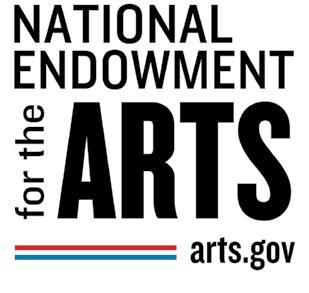
Lope de Vega’s Fuente Ovejuna was written in approximately 1612 and inspired by a real 1476 i ncident: farmers and peasants of the village of Fuente Ovejuna in the region of Castile, Spain, rose up against a military commander and his soldiers garrisoned in the village, who routinely assaulted the women and brutalized and oppressed the villagers. Some of the themes of Fuente Ovejuna are feminism, sexual violence, class, collective resistance and human rights; and of course, Lope de Vega wrote his play long before America’s Declaration of Independence, the French Revolution, 19th Amend ment to the Constitution and today’s #MeToo movement.
However, as noted by Jonathan Kalb, TFANA’s resident dramaturg, “during the Spanish Civil War, Fuente Ovejuna was performed by both sides, the Falangists and the Republicans, each bent on using it to support their own view of the nation. The play was also performed under the Czar and was perfectly credible then as a celebration of Czarist wisdom and power; later it was performed just as successfully by the Bolsheviks. Lope de Vega altered the story in his sources, just as Shakespeare did with many of his plays. Whether the story as Lope de Vega tells it is liberal or conservative, whether it should be understood to endorse revolution or central authority and mon archy, has been disputed for a very long time.”
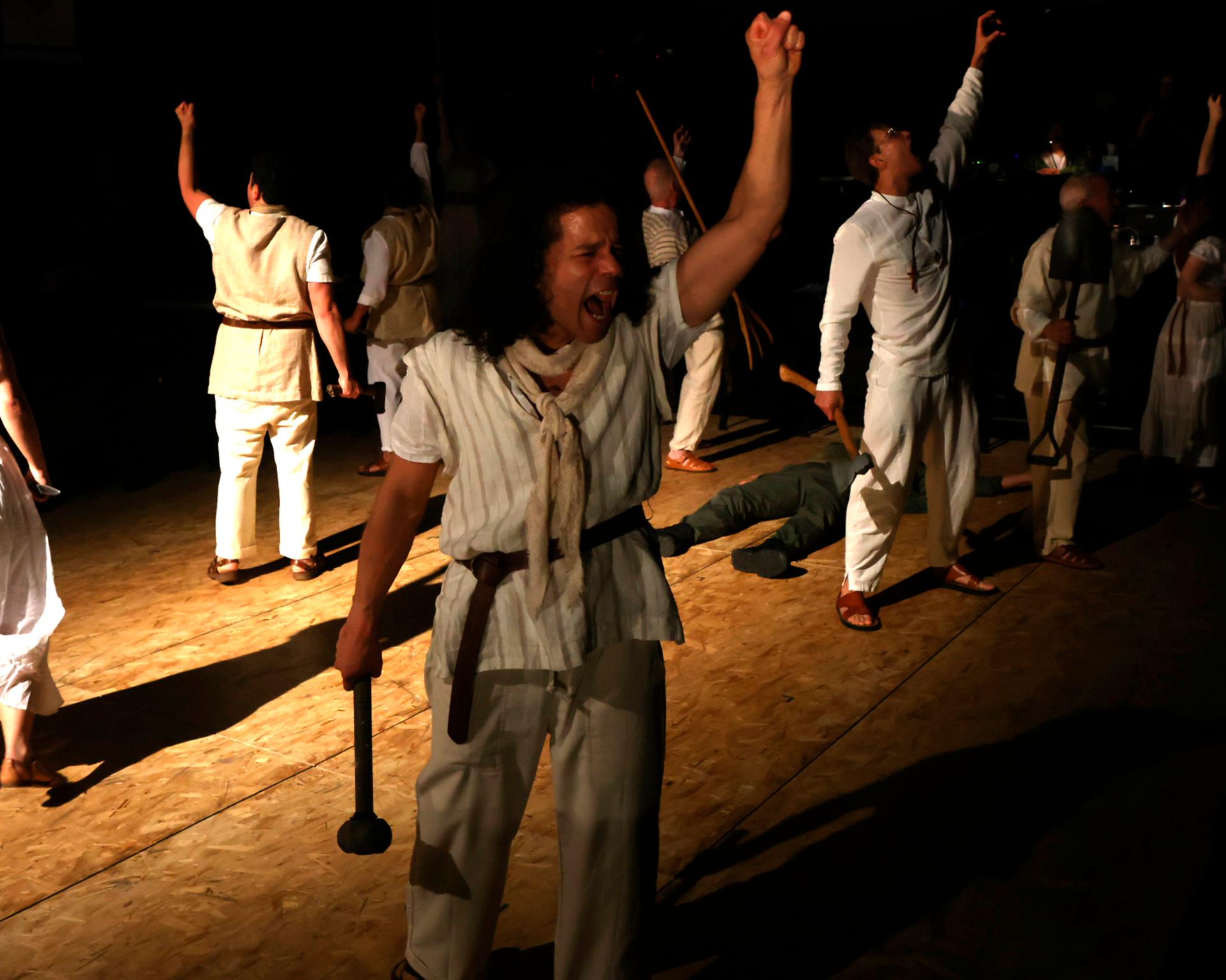 Jeffrey Horowitz
Jeffrey Horowitz
Our 2022-23 Season is dedicated to Celebrating the Memory of Peter Brook. From 2008-2019, TFANA was honored to present seven New York Premieres of works by Shakespeare, Dostoyevsky, Beckett and new plays by Peter Brook and MarieHélène Estienne directed by Peter or co-directed by Peter and Marie-Hélène.

Notes
Front Cover: Art by Paul Dav is.
This Viewfinder will be periodically updated with additional information. Last updated May 16, 2023.
Credits
Fuente Ovejuna 360° Edited by Nadiya L. Atkinson
Resident Dramaturg: Jonathan Kalb Council of Scholars Chair: Tanya Pollard Designed by: Milton Glaser, Inc.
Publisher: Theatre for a New Audience, Jeffrey Horowitz, Founder and Artistic Director

Fuente Ovejuna 360° Copyright 2023 by Theatre for a New Audience. All rights reserve d.
With the exception of classroom use by teachers and individual personal use, no part of this Viewfinder may be reproduced in any form or by any means, electr onic or mechanical, including photocopying or recording, or by any information or retrieval system, without permission in writing from the publishers. Some materials herein are written especially for our guide. Others are reprinted with permission of their authors or publishers.
FUENTE OVEJUNA 3 2 THEATRE FOR A NEW AUDIENCE 360° SERIES
Production: Cast and Creative Team About Theatre For a New Audience 35 Leadership 36 Mission and Programs 37 Major Supporters
28 The
This production of Fuente Ovejuna is made possible, in part, by an award from the National Endowment for the Arts.
This production of Fuente Ovejuna and its attendant programming are supported by the Consulate General of Spain in New York.
Endowment support for Fuente Ovejuna is provided by the Howard Gilman Fund for Classic Drama.
Carlo Albán (Frondoso). Photo by Hollis King.
Lope de Vega (1562-1635) was the most popular, influential and revered dramatist of the period of national-cultural renaissance known as the Spanish Golden Age.
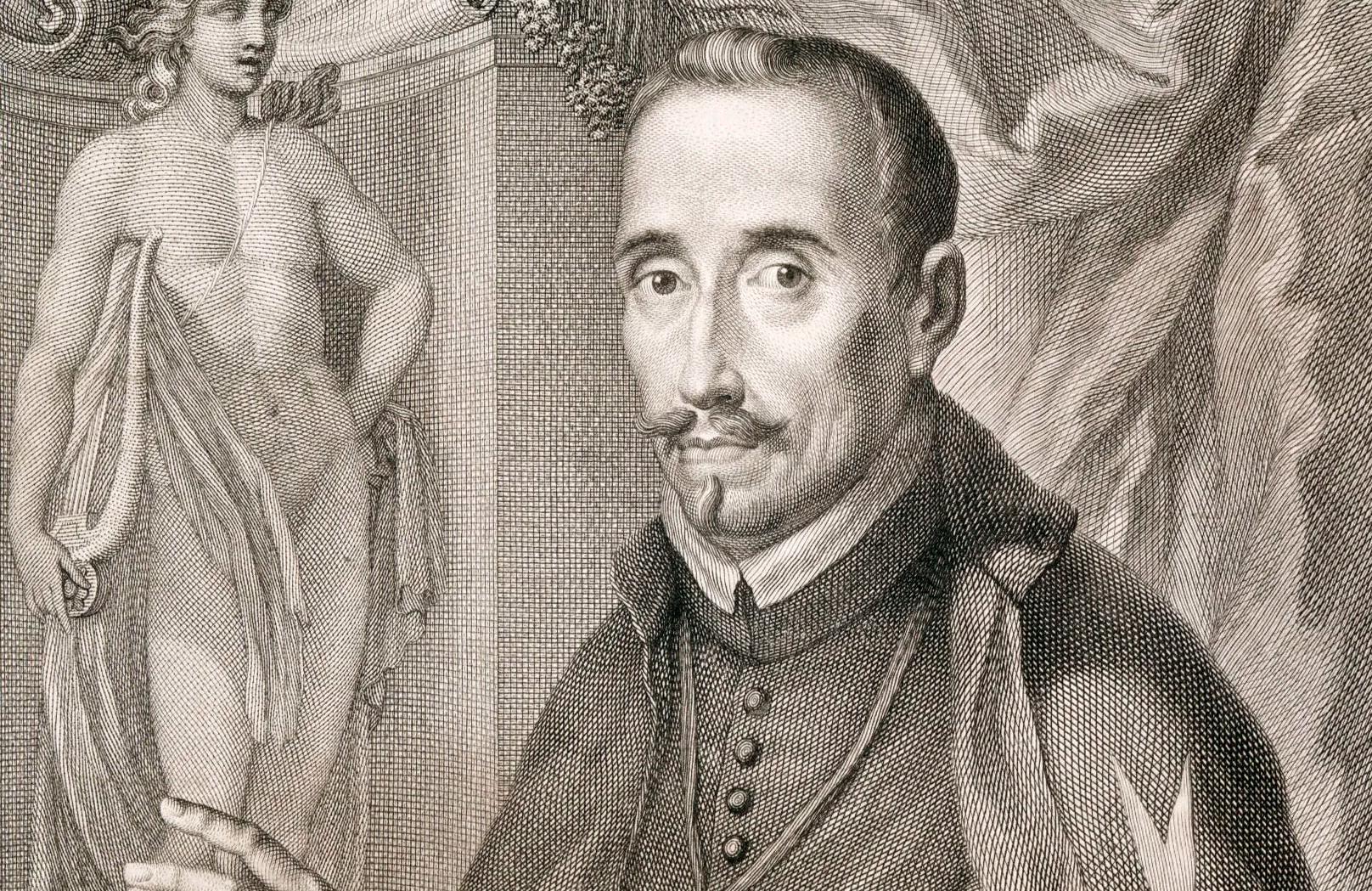
An astonishingly prolific author of as many 1,500 plays, he was the son of an embroiderer who, thanks to a poet-friend, learned Latin and acquired a humanistic education and was recognized early as a talented poet. Studying for the priesthood, he fled to pursue a married woman and then made his living as a playwright for the burgeoning public theaters ( corrales ) and as a secretary to several aristocrats. He eventually became the dominant theatrical figure of the era, responsible more than any other artist for developing the 3-act Spanish dramatic form comedia into a distinctively dynamic literary genre and entertainment vehicle that mirrored Spanish cultural pride, mining (among other sources) the deep vein of history, myth, romance and adventure from the 781-year Reconquista . Catholic Spain was the most powerful and confident nation on Earth during the Golden Age, and its dramatists were expected to celebrate the crown, the church, the traditional honor code, and the nation’s triumphal self-image. The best works of the period—like Fuente Ovejuna (written c. 1612-14)—nevertheless absorbed and preserved more complex and penetrating truths about their society than their authors may have understood.
Lope was a handsome, dashing, romantically impulsive man who fought with the Spanish Armada, once lived with two women as wives simultaneously, experienced crushing heartbreak, and eventually became a priest. He was as notorious to his contemporaries for his scandalous personal life as for his art and became the subject of abundant legend and exaggeration. More than 450 of his plays survive. The Spanish expression “es de Lope!” is understood to mean, “it’s good!”
BIOGRAPHY ADRIAN MITCHELL
Adrian Mitchell (1932–2008) was born in London and studied English at Christ Church, Oxford. He worked as a journalist until the mid-60s, when he embarked on a career as a prolific poet, playwright, and novelist.

Mitchell gave frequent public performances of his searing satirical work, which was often driven by his strong commitment to leftist politics and pacifism, including his involvement with the Campaign for Nuclear Disarmament. The New York Times described him as “British poetry’s voice of the left.” He collaborated with Peter Brook on the revolutionary Royal Shakespeare Company production of Marat/Sade (1964), for which he won the PEN Translation Prize. His vehement antiVietnam War stance became a nexus of his art and activism: in 1964, he read his poem “To Whom It May Concern (Tell Me Lies About Vietnam)” to thousands gathered at a rally in Trafalgar Square and in 1966, he penned the lyrics for Peter Brook’s experimental anti-Vietnam War work US.
Mitchell made indispensable contributions to classic theatre, having translated Spanish Golden Age plays including Pedro Calderon’s The Mayor of Zalamea, Life’s a Dream and The Great Theatre of the World and Lope de Vega’s Fuente Ovejuna and Lost in a Mirror . Other notable theatrical works include Tyger , the adaptation of Gogol’s The Government Inspector , and the lyrics for Peter Hall’s adaptation of Orwell’s Animal Farm , all performed at the National Theatre; and his adaptations of C.S. Lewis’ The Lion, the Witch, and the Wardrobe and Pushkin’s Boris Godunov , both at The Royal Shakespeare Theatre. Mitchell was a fellow of the Royal Society of Literature.
FUENTE OVEJUNA 5 4 THEATRE FOR A NEW AUDIENCE 360° SERIES
BIOGRAPHY LOPE DE VEGA
Lope de Vega. The New York Public Library Digital Collection. Institution: National Library of Spain
Adrian Mitchell. © Billy Fox
DIALOGUES RESISTANCE FROM BELOW
BY BARBARA FUCHS, UCLA
Fuente Ovejuna did it!”—we are all of us responsible, or no one is. Punish us all if you must, or let us off, for we will not name names. The political force of Lope de Vega’s Fuente Ovejuna is apparent to us today, in a time of resurgent belief in collective political action. It was apparent, too, to the Russian leftists who first canonized the play at the turn of the 20th century. And it would certainly have been apparent in its own time, as Spain negotiated the move from feudalism to a modern dynastic state, with monarchs superseding local lords as guarantors of justice. Lope wrote his powerful play around 1610, using an episode from over a century earlier to remind a weak king, Philip III, of how dangerous it could be to let noblemen become too powerful. Based on events in 1476 in a small town near Córdoba, Lope’s plot reprises an earlier moment of great political upheaval, as Spaniards of every social class reconsidered what they owed each other.
In that eventful late 15th century, Spain underwent a profound transformation. In 1469, Isabella of Castile married Ferdinand of Aragon, uniting the two realms. By 1492, they had defeated the Nasrid kingdom of Granada, consolidating their rule. Their central task: how to organize a strong centralized monarchy that would supersede feudal lords while avoiding the excesses of absolutism. The new arrangements transformed the traditional balance of power between king, lords, and vassals, pitting older understandings against the needs of the new state. These political quandaries were hardly abstract questions: they governed the everyday realities of taxation, political representation, and social hierarchies. As Spain took on its foes abroad and at home in countless expensive wars, the issue of how much a ruler could extract from his subjects became particularly pressing. Lope has a particular talent for translating these problems into powerful dramatic terms. As he pits poor villagers against abusive lords, with the wise monarchs as their judges and saviors, he brings to the stage pressing debates over what holds together our social relations: is it consent, divine right, force?
Lop e trains his lens on a particularly vexed history. Any triumphalist account of how Spain became a modern dynastic state (and, in the wake of Columbus’ voyage of the same year, a global empire) conveniently leaves out the contested nature of Isabella’s rule. In order to succeed her half-brother, Henry IV, Isabella displaced his daughter Juana, whose legitimacy was disputed. The conflict soon spread to Portugal as Juana’s future husband, Afonso V, joined the fray, in a war that would consume the first four years of Isabella’s rule. Those tumultuous times required towns and nobles to pick sides, and provide the perfect setting for Lope’s exploration of loyalty and obedience.
T he civil war shapes the frame story of Fuente Ovejuna , with the Commander, who supports Juana’s claim, representing on stage the powerful military order of Calatrava. In a first salvo of Lope’s dramatic irony, the Commander, supremely unconcerned with those below him, fumes at the disrespect he perceives from above, in the person of the young Grand Master of his order. He nonetheless agrees to join the Grand Master in defending Ciudad Real against Isabella and Ferdinand, even though its very name— royal city seems to anticipate its fall to the monarchs. By the end of the play, with the Commander conveniently dispatched for his excesses, Rodrigo will see the error of his ways and be reconciled with Isabella.
S o much for the frame. The actual conflict in and of Fuente Ovejuna, which takes up the bulk of the play, is no less political, though it focuses on the everyday lives of the townspeople and their quotidian experience of authority. If the opening scene reveals how the Commander seethes at those above him, whether the young Grand Master or the sovereigns themselves, the central plot will turn on his behavior to those below him: the townspeople and especially the women of Fuente Ovejuna.
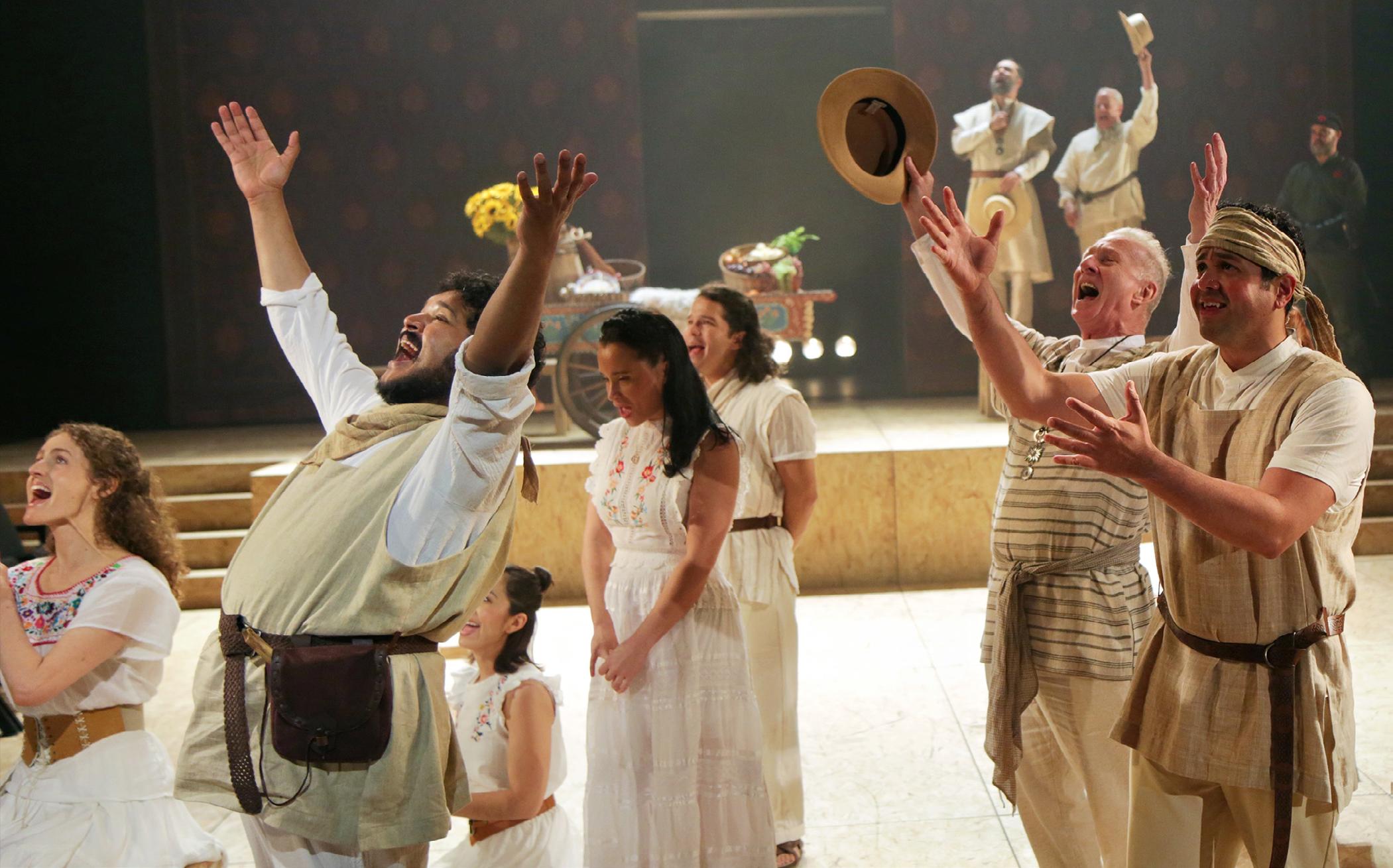
Th e play offers a positive vision of life in a small place. Its young people are witty, articulate, and smart, thoughtfully defending their way of life.
RESISTANCE FROM BELOW BARBARA FUCHS
Their very names—Laurencia, Frondoso—announce their connection to nature (and perhaps also the strength of a protagonist who, unlike Daphne, refuses to become a laurel ). When Frondoso, Barrildo, and Mengo encounter Laurencia and Pascuala, they playfully riff on the insincerity of the city in comparison to their own world. They are also fully capable of debating the nature of love, as Lope sets the stage for the larger questions that will animate the play.
In to this Eden comes the Commander, who misunderstands the nature of his dominion over the town and its people. The historical sources recount that the Commander, “committed great injuries and dishonors to the people of the town, taking their daughters and wives by force, and robbing their households to maintain his soldiers.” When they had finally had enough, the townspeople rebelled, calling out “long live Kings Ferdinand and Isabel,
and death to traitors and bad Christians,” as they killed the Commander and fourteen of his men. The rebels were promptly arrested, and tortured to identify the ringleaders. But since each was willing to die for the others, what could have been one more bloody incident amid the civil war became instead a memorable and even proverbial example of resistance and solidarity.
Lope’s play examines the historical events i n individualized detail, detailing the human costs of transgression at the top. The Commander’s propensity to treat the townspeople—and especially the women— as though they were mere objects at his disposal offers a vision of noble privilege run amok. When the Commander threatens Laurencia, Frondoso rushes to her aid, standing up to a man far above him in the social hierarchy. When the Commander strikes again, on their wedding day, he also defies her father, the mayor of the town.
FUENTE OVEJUNA 7 6 THEATRE FOR A NEW AUDIENCE 360° SERIES
Brenda Meaney ( Pascuala ), Kenneth De Abrew ( Mengo ), Octavia Chavez-Richmond ( Jacinta ), Carmen Zilles ( Laurencia ), Carlo Albán ( Frondoso ), Barzin Akhavan ( Esteban ), Stephen Berenson ( Juan Rojo ), Brian McEleney ( Alonso ), Ricardo Vázquez ( Barrildo ), Paco Lozano ( Ortuño) . Photo by Gerry Goodstein.
RESISTANCE FROM BELOW BARBARA FUCHS RESISTANCE FROM BELOW BARBARA FUCHS
His authority seems boundless, and yet the mayor foresees another world in the offing: “In Castile now a King and Queen/Are bringing peace to all the people/And stamping out petty tyrants.” The people, the play insists, have their own dignity, and any stable political authority requires respecting it. The Commander’s disregard for consent in the sexual sphere foregrounds the equally key problem of the consent of the governed.
Laurencia in particular is a remarkable figure, linkin g the violence done to her as a woman to the larger political stakes. She cannot and will not wait for a change from the outside; instead, she urges the townspeople to revolt by mobilizing the most conservative of ideas about female chastity and patriarchal responsibility, even taunting the men for their lack of masculinity. Yet we should not miss the larger point: not only does she thereby succeed in convincing them, but the ensuing collective action includes women and men alike, forever challenging the idea that wo men need special protection. As the townspeople face the inevitable consequences of their
actions, the women join the men in their collective resistance. They, too, are tortured yet do not break: “Fuente Ovejuna did it,” they insist.
La urencia may be exceptional, but the vision of female agency that she offers is anything but. Lope often wrote for particular actresses—the divas of their time—and the depth and breadth of his female roles honor the women who played them on stage. In Fuente Ovejuna , female agency is evident at all levels of society: Laurencia’s leadership parallels Isabella’s as the defeat of Ciudad Real consolidates the queen’s power. Both as warrior and as judge, Isabella is fully a partner to Ferdinand in the new order that Lope celebrates.
Face d with the extraordinary gesture of solidarity that links the townspeople in collective action, the kings offer a new social contract: the town will remain under their control, at least for the time being, as monarchs and subjects find a new affordance. There is no room for rapacious overlords in this new world: Fuente Ovejuna dispatches not just a very bad apple but the entire fruit bowl of feudalism.
Eventually deemed “the first proletarian drama,” Fu ente Ovejuna became increasingly popular from the nineteenth century on, as critics and audiences warmed to its revolutionary portrayal of resistance. That revolutionary potential is hardly tamed by its monarchical frame: although noted 20th-century productions, such as Federico García Lorca’s for his touring company La Barraca, eliminated the kings altogether to focus on the town’s revolt, royal authority hardly appears all-powerful. Instead, the kings must yield to Fuente Ovejuna’s collective strategy, and rule with the consent of the ruled.
Po litically trenchant yet full of humor and pastoral idealism, Fuente Ovejuna transcends its immediate historical context to serve as a lasting meditation on the power of community. Yet the play would not have such staying power if it were a simple manifesto. Instead, it forces us to ask hard questions about how and where justice must be located. Is violence the only alternative to complacency? Can collective action be mobilized without appealing to the most atavistic of motives? Is it possible, or even essential, to negotiate with corrupt regimes? Countless
adaptations and productions have located these questions in different contexts, from maquiladoras to supermarkets, with the rise of undemocratic forces and the #MeToo movement offering a newly resonant backdrop for us today. .
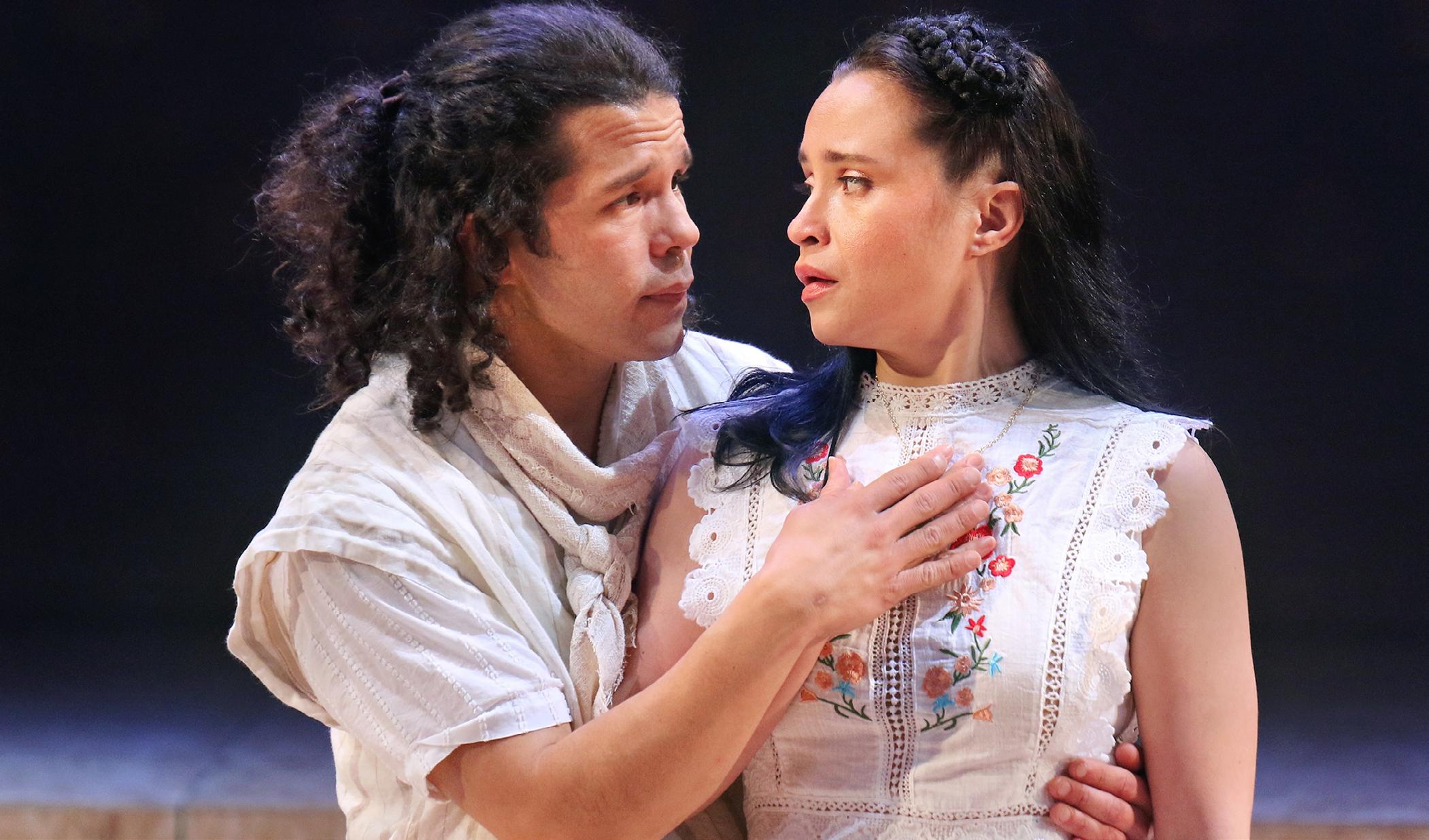
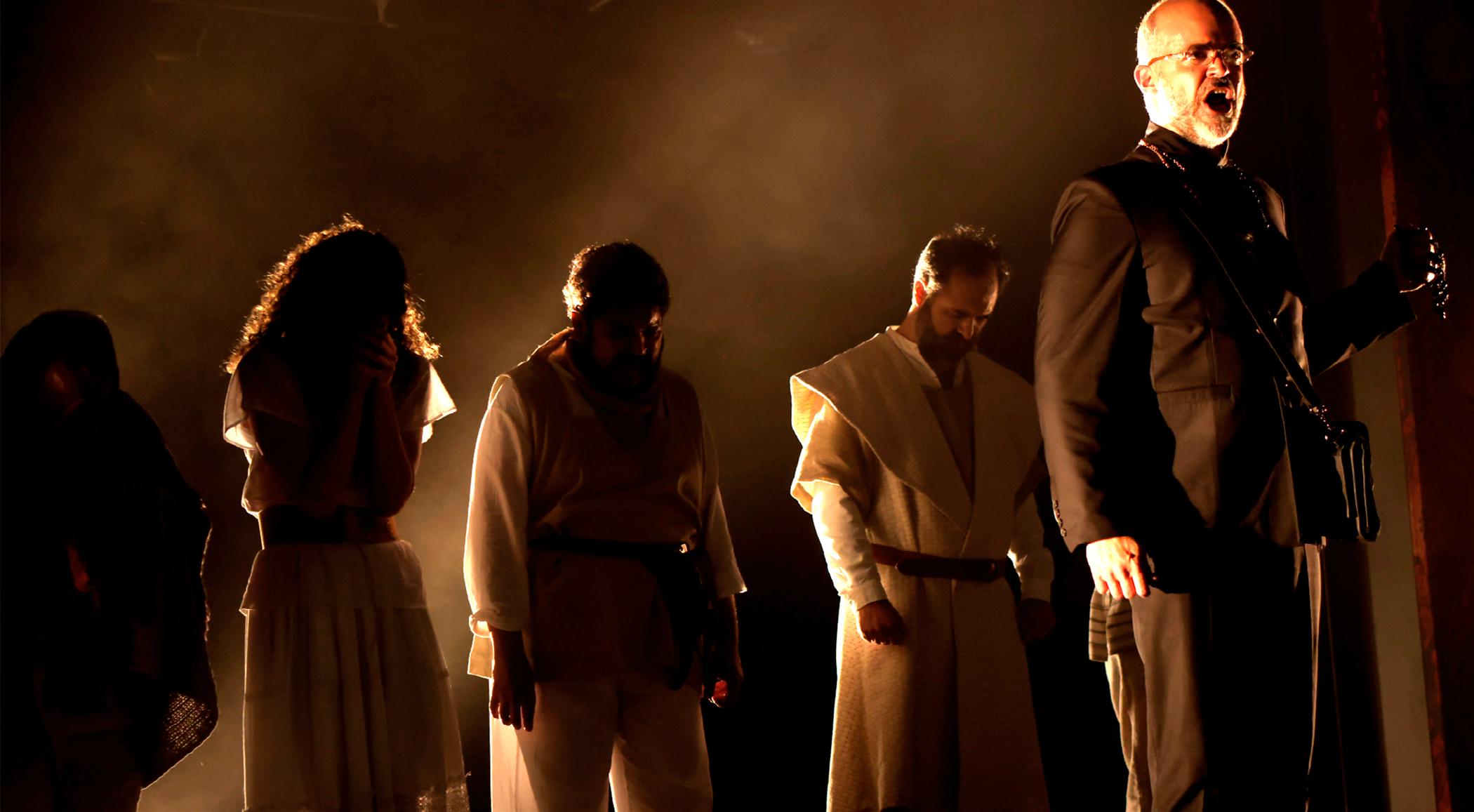
Barbara Fuchs is Distinguished Professor of Spanish and English at UCLA. She is the founder and director of Diversifying the Classics, which has been working to promote Hispanic classical theater since 2014. In 2018, she founded LA Escena, Los Angeles’ festival of Hispanic classical theater. In 2021, her work to promote Hispanic language and culture was recognized with the inaugural Premio Ñ from Spain's Instituto Cervantes.
Professor Fuchs has published widely on early modern literature and culture and on contemporary performance. She has also translated a range of early modern Hispanic classics. Her most recent books are Knowing Fictions: Picaresque Reading in the Early Modern Hispanic World . (Penn, 2021) and Theater of Lockdown: Digital and Distanced Performance in a Time of Pandemic (Bloomsbury/Methuen 2021).
FUENTE OVEJUNA 9 8 THEATRE FOR A NEW AUDIENCE 360° SERIES
Brenda Meaney ( Pascuala ), Kenneth De Abrew ( Mengo ), Barzin Akhavan ( Esteban ), Paco Lozano ( Manrique ).
Photo by Hollis King.
Carlo Albán ( Frondoso ), Carmen Zilles ( Laurencia ). Photo by Gerry Goodstein.
INTERVIEW THE AUDIENCE IS THE COMMUNITY
AN INTERVIEW WITH FLORDELINO LAGUNDINO, MODERATED AND EDITED BY JONATHAN KALB.
THE AUDIENCE IS THE COMMUNITY
idea that a Shakespeare text activates the body, that you regard yourself as a vessel for the work and then it comes out naturally and with fervency. These kinds of exercises lead to really great connections with the audience, and I think that does map onto Lope de Vega.
In both Shakespeare and Lope when you’re fully engaged in the text there’s a sense of your whole body invested in the work. And as a person of color, it’s important to me to be able to live fully on stage with classical material, to be able to present myself as a whole human being. That’s exciting. Look at the way Laurencia speaks in Fuente There’s a full-bodied investment that’s necessary to bring her poetry to life, because she’s talking about such deep and powerful issues of humanity. It’s this involvement with humanity that I’m really attracted to.
JONATHAN KALB Was Laurencia’s storyline what particularly attracted you to the play?
FLORDELINO LAGUNDINO Yes. Laurencia has been attacked by this brutal and powerful man with impunity. And when she then confronts her father, confronts Barrildo, her friends, and the other members of the establishment in her town, the strength and courage it takes to do that are amazing. That’s how the revolution happens within this play, that’s how change happens—through her action of opening the door to this room, stepping through it, and voicing her displeasure. She activates them to a true act of revolution.
JONATHAN KALB Is that activation the main contemporary moment in the play for you? Or do other parts feel contemporary too?
FLORDELINO LAGUNDINO There are others. The conflict between Spain and Portugal, for instance, with this town caught in the middle, feels contemporary to me. You have this Commander, who is their overlord,
This is an edited version of an interview on April 6, 2023 between Flordelino Lagundino, director of Fuente Ovejuna, and Jonathan Kalb, production dramaturg and TFANA’s Resident Dramaturg.
JONATHAN KALB Fuente Ovejuna is a famous play, a canonical work of the Spanish classical repertory, yet like all other Spanish Golden Age plays, it’s rarely produced on major American stages. How did you first come upon it?
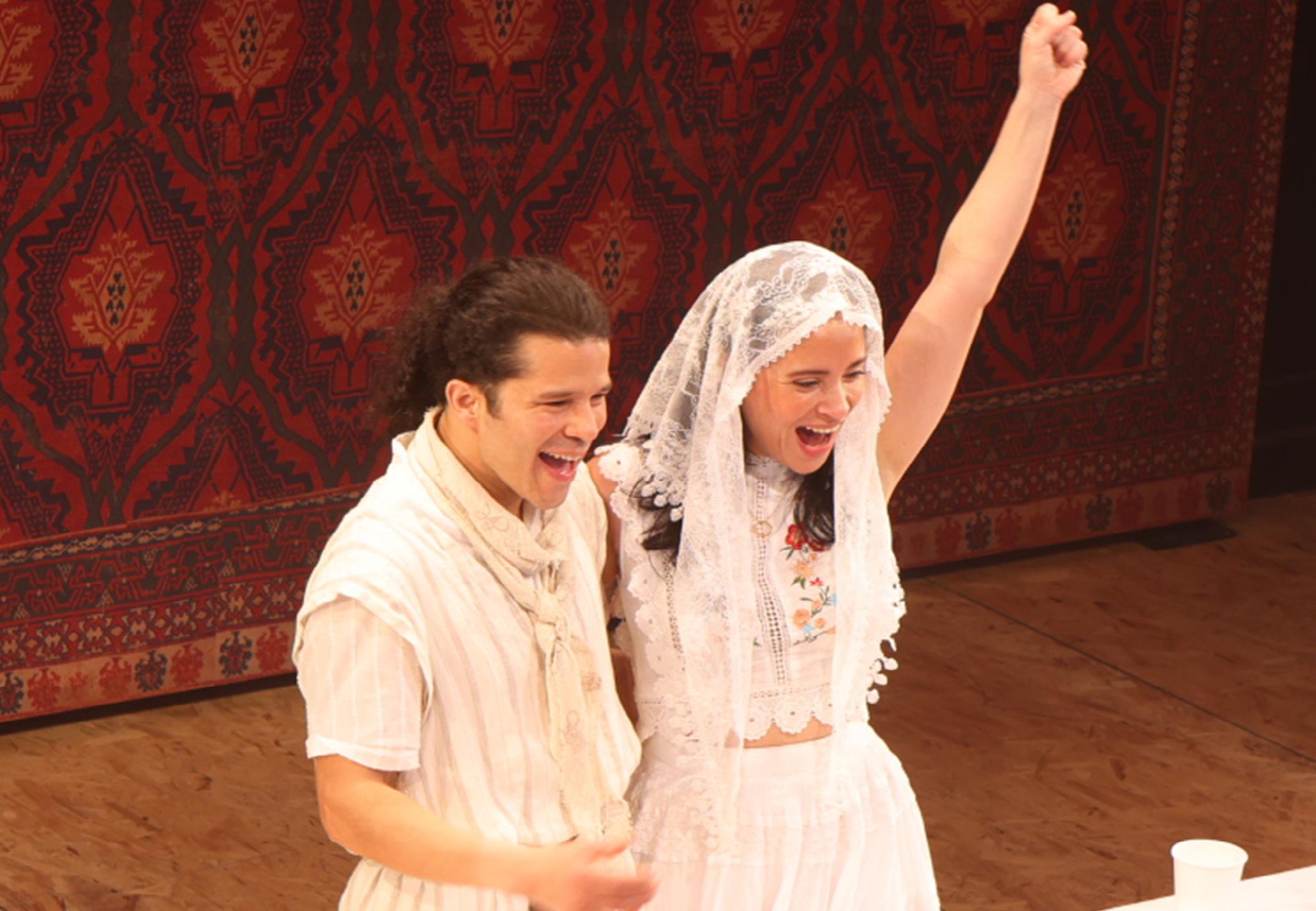
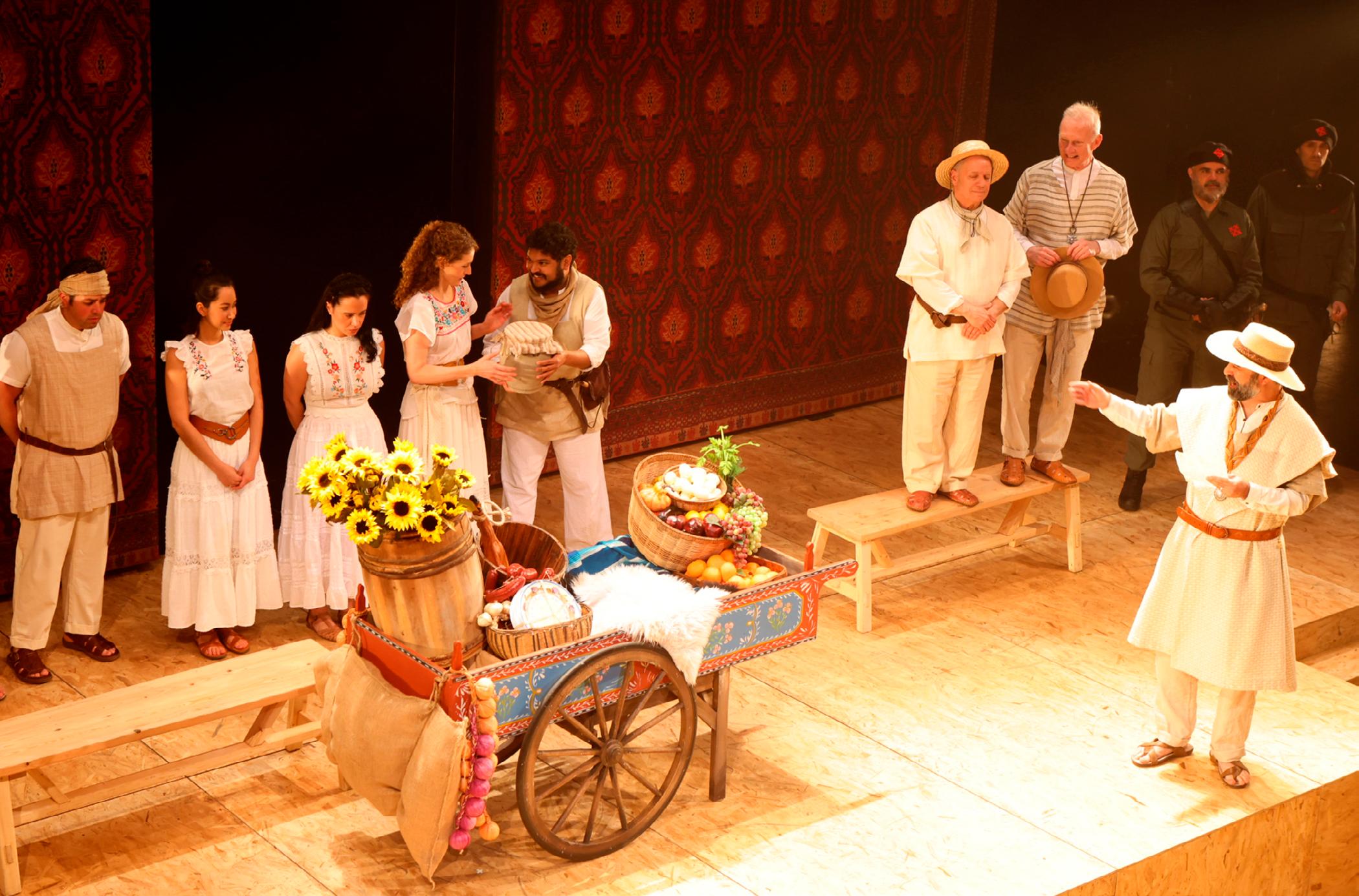
FLORDELINO LAGUNDINO Jeffrey Horowitz sent it to me. He saw my work in 2017 when I participated in the Actors & Directors Workshop at TFANA, and we met afterwards and formed a relationship. I’d never read Lope de Vega before, and if I had any impression of the Spanish Golden Age it was that those plays are pretty removed from us in the United States. But I read the play and was really struck by how current some of the ideas of revolution in it were. Particularly
during that time, around 2018, it brought things percolating up in me. The character of Laurencia, for instance, goes through these horrific events, these horrible things that happen to her, circumstances she is thrown into, and she has this resiliency and strength to fight through them that’s really beautiful. Her ability to lead the town in a collective action of revolution and self-awareness and self-understanding of their humanity is inspiring.
JONATHAN KALB I know you’ve directed Shakespeare— Macbeth and A Midsummer Night’s Dream . Does Lope de Vega map onto that interest?
FLORDELINO LAGUNDINO My first training was as an actor, so I’m very familiar with the Cicely Berry and Patsy Rodenburg exercises used in the Actors & Directors Workshop. When I went to graduate school in directing at Brown/Trinity we used them too. All are based on the
FUENTE OVEJUNA 11 10 THEATRE FOR A NEW AUDIENCE 360° SERIES
Carlo Albán (Frodonso) and Carmen Zilles (Laurencia) Photo by Hollis King.
Ricardo Vázquez (Barrildo) Octavia Chavez-Richmond (Jacinta), Carmen Zilles (Laurencia), Brenda Meaney (Pascuala), Kenneth De Abrew (Mengo), Stephen Berenson (Juan Rojo), Brian McEleney (Alonso), Paco Lozano (Ortuño), Barzin Akhavan (Esteban). Photo by Hollis King.
and he creates events that oppress them. But then also—though I don’t know how much I want to go into this—when Jeffrey gave this to me it was the Trump era. And at that time the question of what it means to be a good ruler, to take care of the people you rule over, was very much on my mind.
JONATHAN KALB What’s your hesitation to talk about that? Is it no longer pertinent?
FLORDELINO LAGUNDINO No, it’s still very pertinent. I think my hesitancy is that I think the Commander is more multi-faceted than the image you get in pointing to Trump. There’s more than one issue going on with the Commander’s oppressiveness, and the actor Jonathan Cake is really looking a lot now at what causes him to be so despicable. At the beginning of the play, he seems to want to gain more acceptance, more power from the Master, a younger person whom he serves. And then lots of things happen to cause him to feel either elated or as if he’s not good enough as a human being.
JONATHAN KALB So you’re trying to make the Commander a dimensional human being?
FLORDELINO LAGUNDINO Yeah. I think that’s dramatically much more interesting than, you know, a moustache-twirling villain.
JONATHAN KALB And you’re finding that complexity?
FLORDELINO LAGUNDINO I think so. Jonny Cake, who is playing the Commander, is doing a fantastic job developing the character.
JONATHAN KALB Can one defend the Commander?
FLORDELINO LAGUNDINO Not in terms of his actions, no. I mean, he’s trying to literally rape somebody. That’s inexcusable. But it’s helpful if we understand the trajectory of what brings him to that, his drive to power and domination. We should also understand the events that lead to that.
JONATHAN KALB The characters with the most power in this play are the King and Queen, Ferdinand
and Isabella, who are mythologized by Lope—and by Spain in general—as perfect, benevolent, allwise saviors and creators of their nation. Is there any corollary in our time for such idealized rulers?
FLORDELINO LAGUNDINO Probably not. I don’t know if we have anything like that in our time. Certainly we don’t look at Biden or Trump in those ways. I don’t know if, as modern Americans, we can see any leaders in those terms.
JONATHAN KALB Then how should we see these monarchs in the play?
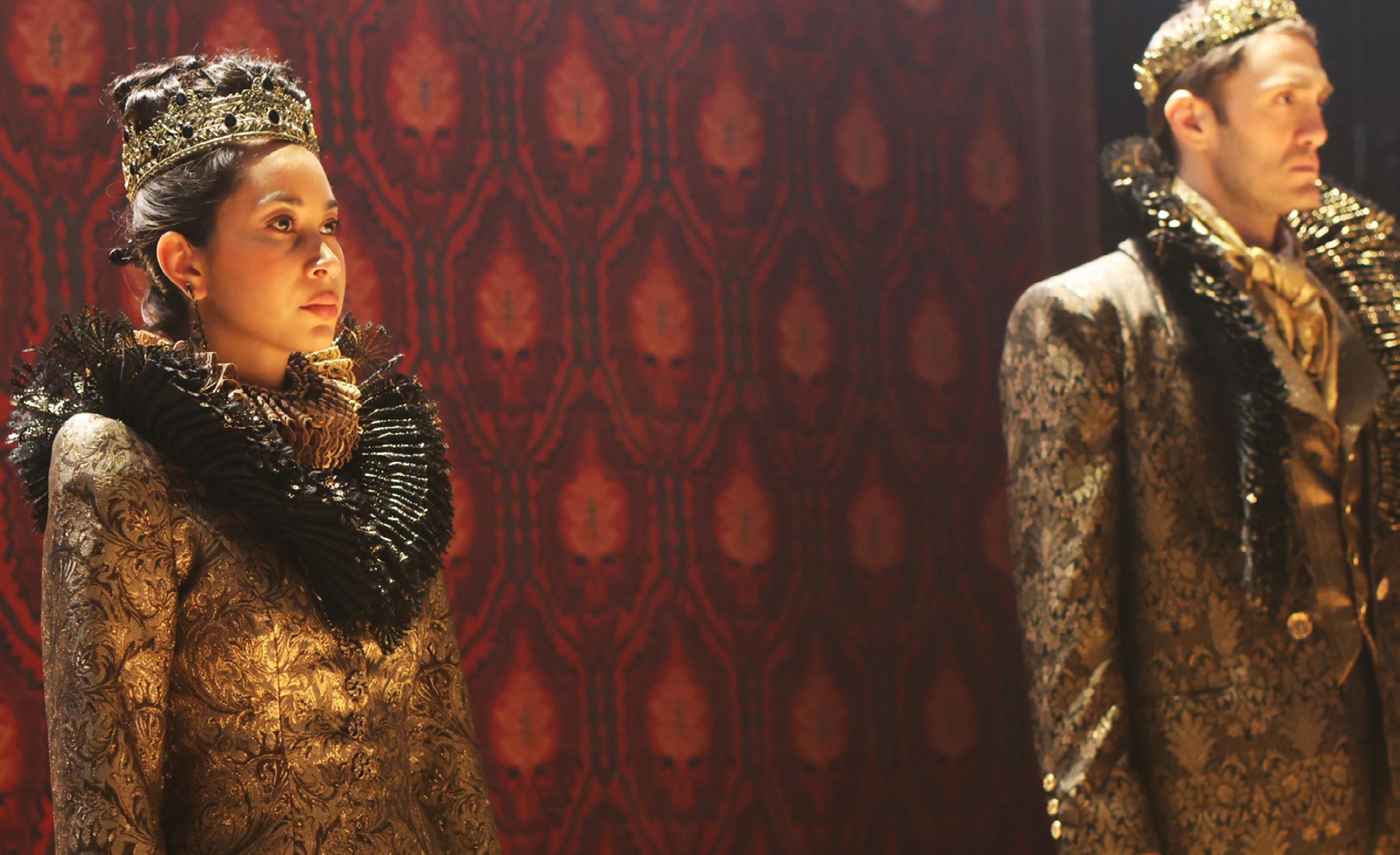
FLORDELINO LAGUNDINO What I’m interested in is the question, where do we put our trust? At the very end, the town of Fuente Ovejuna puts its trust in Isabella and Ferdinand, but today we know that they will go on to dominate other peoples as colonial oppressors, right? We have people in our cast and design team from different countries who have put their trust in leaders who became dominating and authoritarian. So the question is always there with us: where do we
put our trust in leadership? How do we put our trust in leadership? And what does leadership mean?
On second thought, I do think that there are individuals and groups that idealize certain leaders in our society. And this play highlights the care that citizens need to take in selecting the caretakers of this democracy.

JONATHAN KALB Diverse casting has been important to you from the beginning of this project. Can you talk more about why?
FLORDELINO LAGUNDINO Well, the most important thing for me is making this a universal story. It so happens that a lot of the good actors who came through our doors, who I felt were right for this particular telling, were from different countries. They were from England and Western European backgrounds and also from Sri Lanka, Iran and LatinX backgrounds. What’s really great about this is that we’re learning a lot from different experiences and we’re able to put that into the play. It’s building a deeper understanding of the violence in the play. Many
FUENTE OVEJUNA 13 12 THEATRE FOR A NEW AUDIENCE 360° SERIES
Brian McEleney (Alonso), Paco Lozano (Ortuño), Jonathan Cake (Commander Fernando Gomez de Guzman), Jack Berenholtz (Flores). Photo by Gerry Goodstein.
THE
AUDIENCE IS THE COMMUNITY
THE AUDIENCE IS THE COMMUNITY
Octavia Chavez-Richmond (Queen Isabella), Ben Chase (King Ferdinand). Photo by Hollis King.
THE AUDIENCE IS THE COMMUNITY
different perspectives on the place of women in society and their relationship to men, to government, to their bodies, are in the room.
JONATHAN KALB Does this diversity affect the nature of the outrage in the play, or how the cast thinks about it?
FLORDELINO LAGUNDINO I think so. During the time period of the play—and we’ve discussed this a lot—there were no recognized human rights. So in rehearsal we have to develop our own relationship to what’s happening. Obviously today in America, if a woman experienced this level of sexual harassment, she’d have ways of combatting it, tools to fight back. But those tools don’t exist everywhere even today. Some women are better protected than others. Within the cast we have access to different histories that inform subtleties of response to the play’s situation. Some actors have commented that they know what it means to have to be alert, like the play’s villagers, to the need to protect their families, or themselves.
I mean, the thing is, there may be no recognized human rights in this play’s world, but what happens goes against our sense of our humanity, and the villagers’ too. We all feel a need to restore that sense for ourselves. Esteban, the town’s co-mayor and Laurencia’s father, talks about this in his dialogue with the Commander, when he says “you should treat us with respect.” He believes the town has dignity and honor and wants them restored. So although the townspeople may not have rights, they have something within themselves as a community that they want to protect and restore.
JONATHAN KALB Can you talk about the cast’s doubling of roles?
FLORDELINO LAGUNDINO Sure. The original production of this play must have had 20 to 30 actors, but ours has 14. This presents interesting opportunities. For example, Octavia ChavezRichmond, the actor playing Queen Isabella, the most powerful person in the play, will also play Jacinta for us, the least powerful person. And José Espinosa, who plays the Master of Calatrava, the young man who
makes a decision about going to war in Ciudad Real and wants to pull the country of Portugal into his sphere of influence, will also play a farmer and a priest. We will see these people doing two or three different roles, and that will add a complexity to the action. It also, I think, will help humanize the story and help the actors understand the breadth of the society.
JONATHAN KALB Fuente Ovejuna is often revived in the spirit of political advocacy. In the past, it’s been typically produced either to express pride in a monarchy, faith in the wisdom of some strong central ruler, or to express support for a rebellion. Do you see your production in these terms at all?
FLORDELINO LAGUNDINO I think so. When people have asked me, what do you want people to take away from this show, I’ve been telling them I want them to be motivated. Motivated for any change that they want to make in their lives, whether it be in themselves or in society. “Revolution” is a very strong word, but that experience is at the core of the play’s events. Some people could use this play to support the actions of January 6th. You could totally do that. It was a revolution, an attempted overthrow, right?
As a person of color, as a Filipino man, I want to be able to have the strength and courage to stand up for things that I believe in. I want to feel that if I see something, I will say something. Ideally the play should make you feel that if you see something that contradicts what you believe is moral or right, you can have the courage to put your body or your mind on the line to make a change. Even small revolutions or systemic changes in the world can lead to a better society. And that could apply to women’s rights, or abortion rights, or lots of other things.
JONATHAN KALB You just began by speaking about January 6th and then ended with points that lean left. You and I have talked about the longstanding debate among scholars as to whether the play leans right or left politically. Will your production lean left?
FLORDELINO LAGUNDINO That’s an interesting question. Probably. It feels likely. But I also think that if somebody who leans right sees it they may see something
THE AUDIENCE IS THE COMMUNITY
that appeals to them as well. I hope that everyone who comes will gravitate to this idea of revolution or enacting change, and I’m excited about that.
JONATHAN KALB I’ve heard you say that the play does not have a happy ending. But Lope de Vega was probably under the impression it did have one.
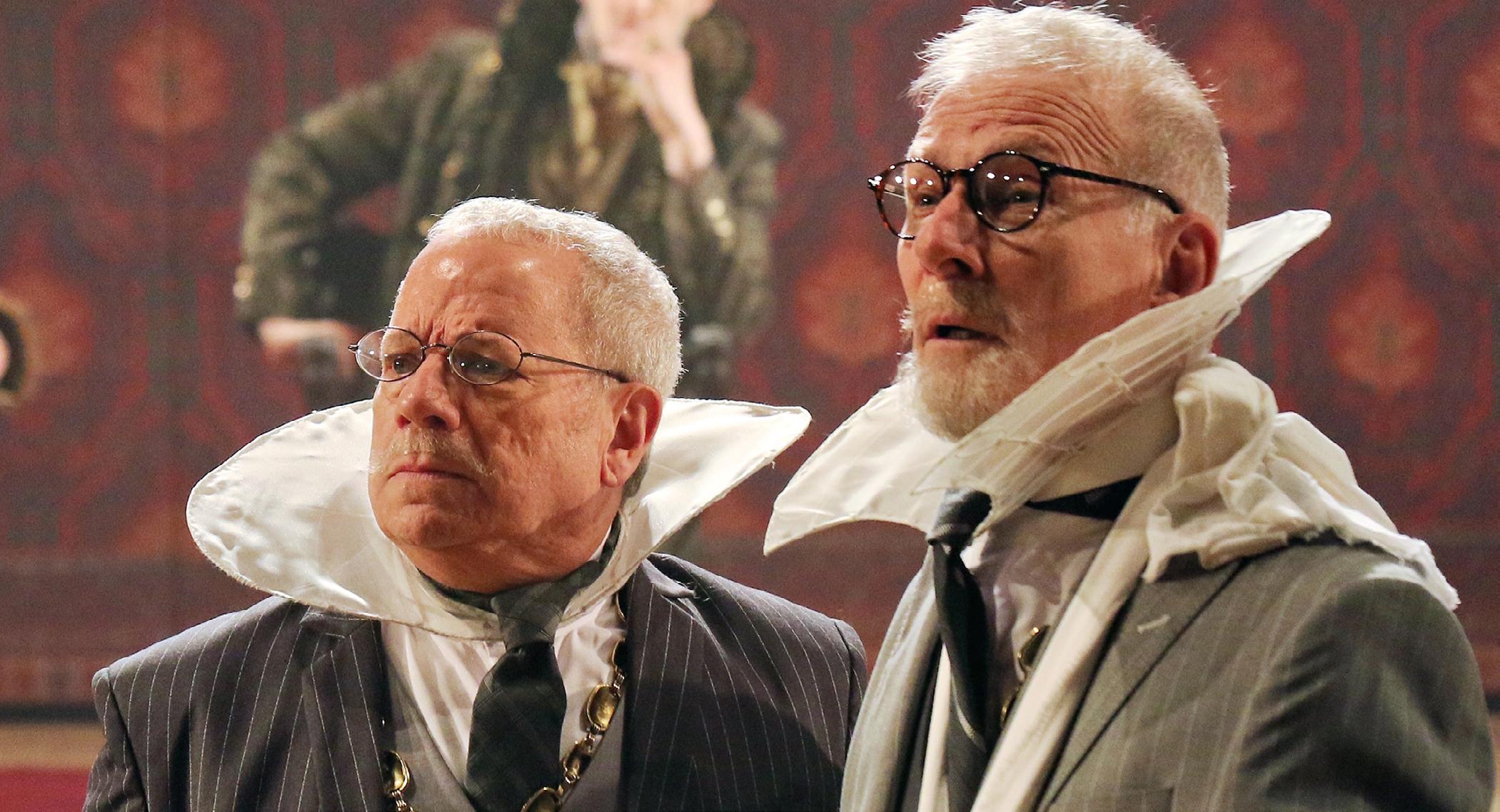
FLORDELINO LAGUNDINO Well, it’s readable in different ways, and I’m not exactly sure yet how our production will end. But part of the point of the ending is that we have to always carefully consider the choices we make, particularly in regard to our leaders. Ferdinand and Isabella are in charge and praised at the end but, as I already said, they go on to conquer many nations, to dominate and colonize peoples around the world. We want our leaders to care for us and to respect our humanity, we give them the power and authority to do that, but they can turn on us.
JONATHAN KALB So you want a mixture of feelings at the end.
FLORDELINO LAGUNDINO Yes. Laurencia ends the play, and that is a little bit of a happy ending since we see her alive and there can be hope. But I’m not sure
we want to highlight the happiness of it. Some horrific things happen in this play. The Commander rapes someone, and then that woman inspires the town to kill him in a really horrific way—I mean, they tear him to pieces. We need to be able to ruminate on those things, those consequences.
JONATHAN KALB What about the physical world of the play? How did you approach the main design concept?
FLORDELINO LAGUNDINO We are telling a story that was written in 1614, about a time period 134 years earlier. We are definitely acknowledging that it was written and set in those periods but with a nod to the fact that we are people in 2023 telling this story. So our men are wearing suits, but with collars that show that they are from a different time period. That was the costume designer Linda Cho’s design choice. So we’re using the story and the original time periods but in a way that gives us enough distance to be able to look at them with fresh eyes.
JONATHAN KALB Why did you choose the deep thrust orientation for the theater? You and I talked a bit about the corrales, the public theaters in Golden
FUENTE OVEJUNA 15 14 THEATRE FOR A NEW AUDIENCE 360° SERIES
Stephen Berenson (First Alderman), Brian McEleney (Second Alderman). Photo by Gerry Goldstein.
THE AUDIENCE IS THE COMMUNITY
Age Spain, which were built into courtyards. And then Jeffrey Horowitz, at the first rehearsal, spoke about his memories of the Cottesloe Theater in London, which was the main architectural model for the Polonsky Shakespeare Center.
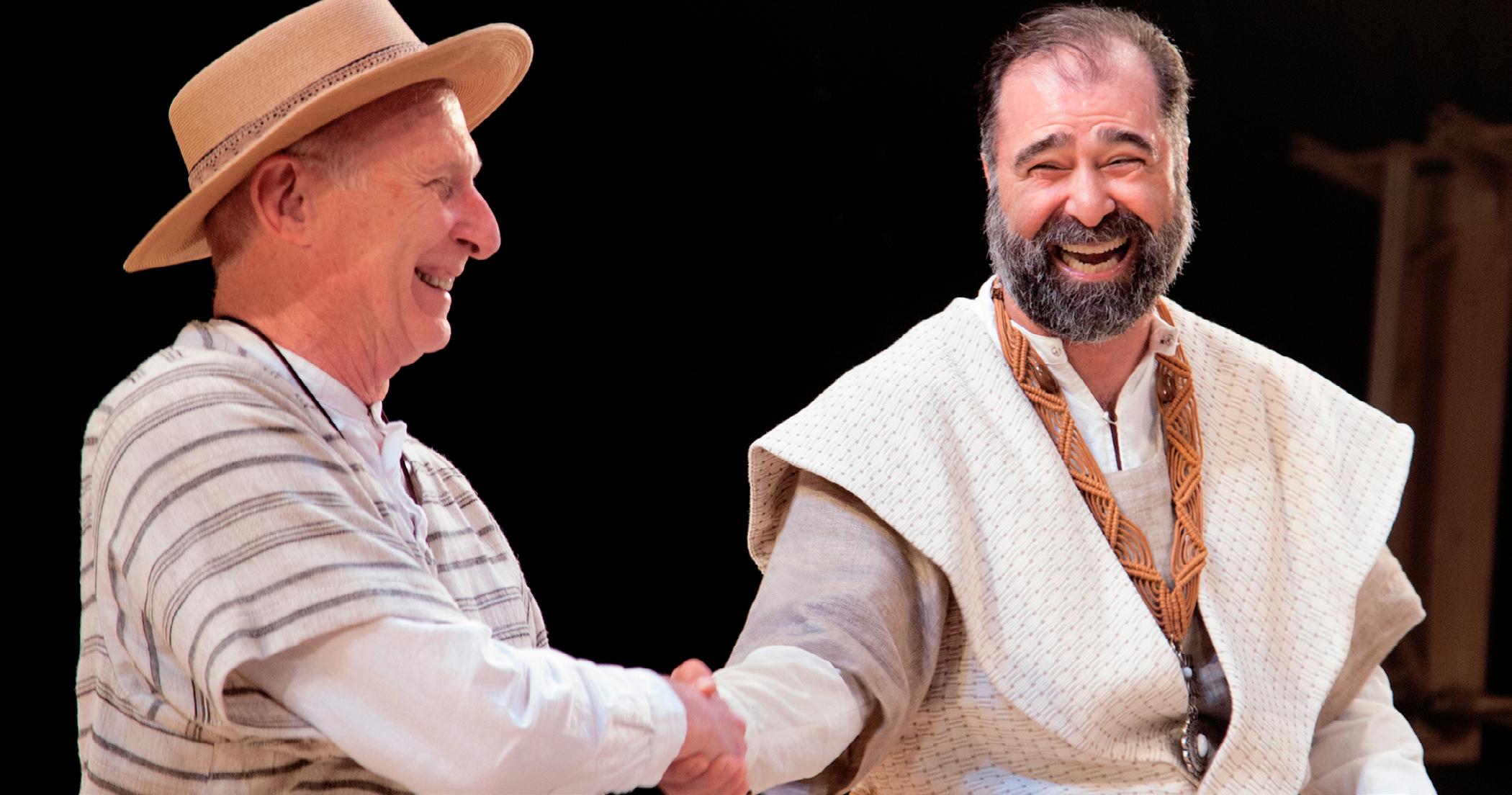
FLORDELINO LAGUNDINO The corrales were an end-stage arrangement, set up at the end of courtyards. They had a sense of people being all around the stage, people high up to the sides and people pressed up in front of the stage, a feeling of surround but not exactly in the same way as the Cottesloe or the Polonsky. At the Polonsky, in our thrust configuration, we’re using the balconies too, and the actors will be activating the space so that we feel like a community. The audience is the community, and we’ll be watching each other and the actors as part of it. We’re casting the audience as a participant in this play.
There will also be direct address, which is a nod to Shakespeare. I’ve seen other plays at the Polonsky do this— A Midsummer Night’s Dream , for instance— open into the whole space, with the play happening all around the theater. It’s really exciting to have that visceral feeling of energy, of bodies, of actors running
around you, or acting over top of you, or hearing sound from all different parts of the theater. We’re definitely trying to create an experience that feels immersive and where we can see each other and each other’s reactions. This is a play about a civic discovery.
JONATHAN KALB Will that immersion and involvement extend to feelings of rebellion, do you think? Do you want the audience to rebel with the townspeople?
FLORDELINO LAGUNDINO I had a conversation with somebody a few months ago who said she saw this play in Spain once, and it was like a rollercoaster. A scene about love happens and then you have this really horrific scene of violence against women, and then you have a marriage. It goes up and down and back and forth in extreme ways. So yeah, I want to have that sense of all these events happening and us participating in it, and seeing ourselves participating. This person also told me that in Spain the audience shouted “Fuente Ovejuna, Fuente Ovejuna” along with the actors. I hope we get to a place where people feel that activated, feel comfortable enough to exclaim, be on the edge of their seats, and participate. .
THE ORIGINALITY
BY CARLOS BOUSO Ñ O, ROYAL SPANISH ACADEMY
The originality of Fuente Ovejuna represents, from a thematic point of view, a profound revolution in the European theater of the seventeenth century: for the first time, the commoner, within the framework of Western culture, appears in dramatic works as a heroic figure, in the same sense that the nobleman can be.

To this surprising phenomenon are added three others: the rogue of El Lazarillo de Tormes , a creature of the lowest social extraction, becomes for the first time a non-comical protagonist of a play; throughout Don Quixote , Sancho, a man of the people, acquires an evident dignity; and, in Velázquez's painting, the same happens with the fool and the dwarf. We can say that, in addition to the genius of the respective authors, there is ‘‘something’’ social in our country that has allowed such a sharp departure from the literary conventions of that age.
That "something" is, undoubtedly, the importance of the people in the history of Spain: already in the Tenth century, due to the Reconquista and the phenomena that resulted from it, Castile became a region of free men within feudal Europe. This gave the villager an importance and influence, and even a sense of dignity, which he did not have in other countries. The villagers of Fuente Ovejuna revolt against their lord, the Commander of the place, supported precisely by that dignity that does not come from aristocratic titles but lies in the honesty of conduct. This conception, so innovative and audacious at the time, was based on certain Renaissance ideas about the value of the individual. But only in Spain did it have scenic repercussions, because only here did these notions, typical of Renaissance thought, fit and gave meaning to feelings deeply rooted in our people, for the abovementioned historical reasons.
Let us not forget that one of Lope de Vega's greatest values was, precisely, the creation of a national theater, a theater for all, aristocrats and commoners, educated and uneducated, to achieve which he needed to rely on the feelings that everyone shared.
And this feeling of the dignity of the person was, without doubt, in Spain, one of them. Hence, the modernity of Fuente Ovejuna .
This does not imply that this is a work that exalts the idea of the freedom of the people, since what moves Lope here is not such a thing (although some interpreters have thought so). It is undoubtedly a very different sentiment: that of justice, and the possibility (proclaimed, let it be said in passing, and this is no accident, by Spanish authors) of tyrannicide, in the event that, in effect, the lord violated the two premises on which his authority was based: loyalty to the king and the protection of his own vassals. Both duties were, in Fuente Ovejuna , trampled by
FUENTE OVEJUNA 17 16 THEATRE FOR A NEW AUDIENCE 360° SERIES
Brian McEleney (Alonso), Barzin Akhavan (Esteban). Photo by Hollis King.
DIALOGUES
OF FUENTE OVEJUNA Ricardo Vázquez ( Cimbranos ), José Espinosa ( Grand Master ).
Photo by Gerry Goodstein.
THE ORIGINALITY OF FUENTE OVEJUNA CARLOS BOUSOÑO
the Commander, according to Lope, and this is what dignifies and gives meaning to the rebellion.
Ultimately, this play is a plea in favor of absolute monarchy in the face of the dispersion, chaos and injustice represented, on multiple occasions, by the last remnants of feudalism, already on the verge of extinction. But all this in no way diminishes the author's originality, which could not be more profound. But, above and beyond what we have said, Fuente Ovejuna stands out for its dramatic force and the perfection of its theatrical development. Lope achieves here, without a doubt, one of his most powerful and excellent works. .
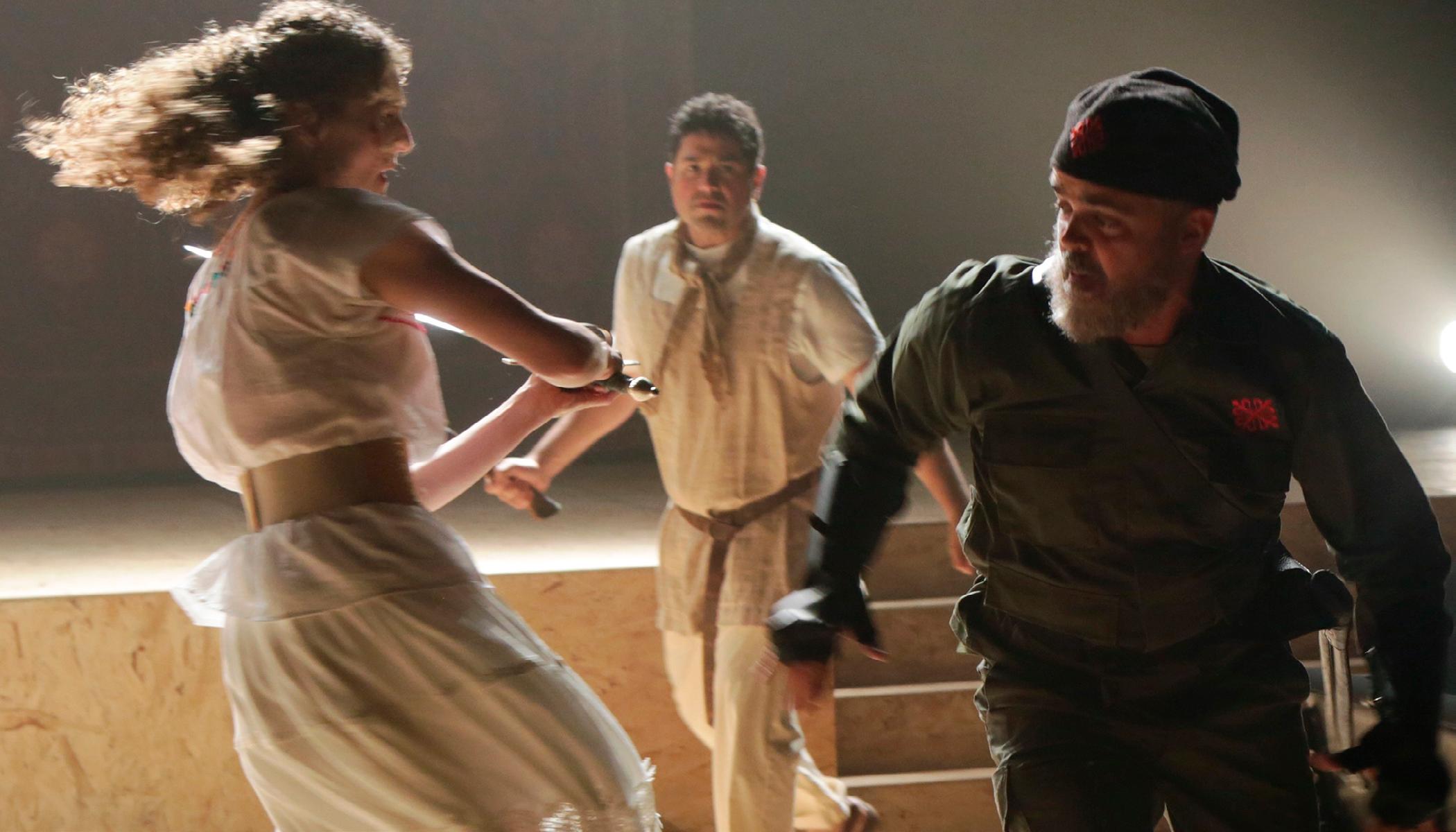
Carlos Bousoño (9 May 1923 – 24 October 2015) was a Spanish poet and literary critic. His work is frequently associated with the post-Spanish Civil War literary group. Bousoño was a recipient of both the National Prize for Spanish Literature and the Prince of Asturias Award for Literature. Vicente Aleixandre's bisexuality was well known to his circle of friends, but he never admitted it publicly. He had a long-term love relationship with Carlos Bousoño.
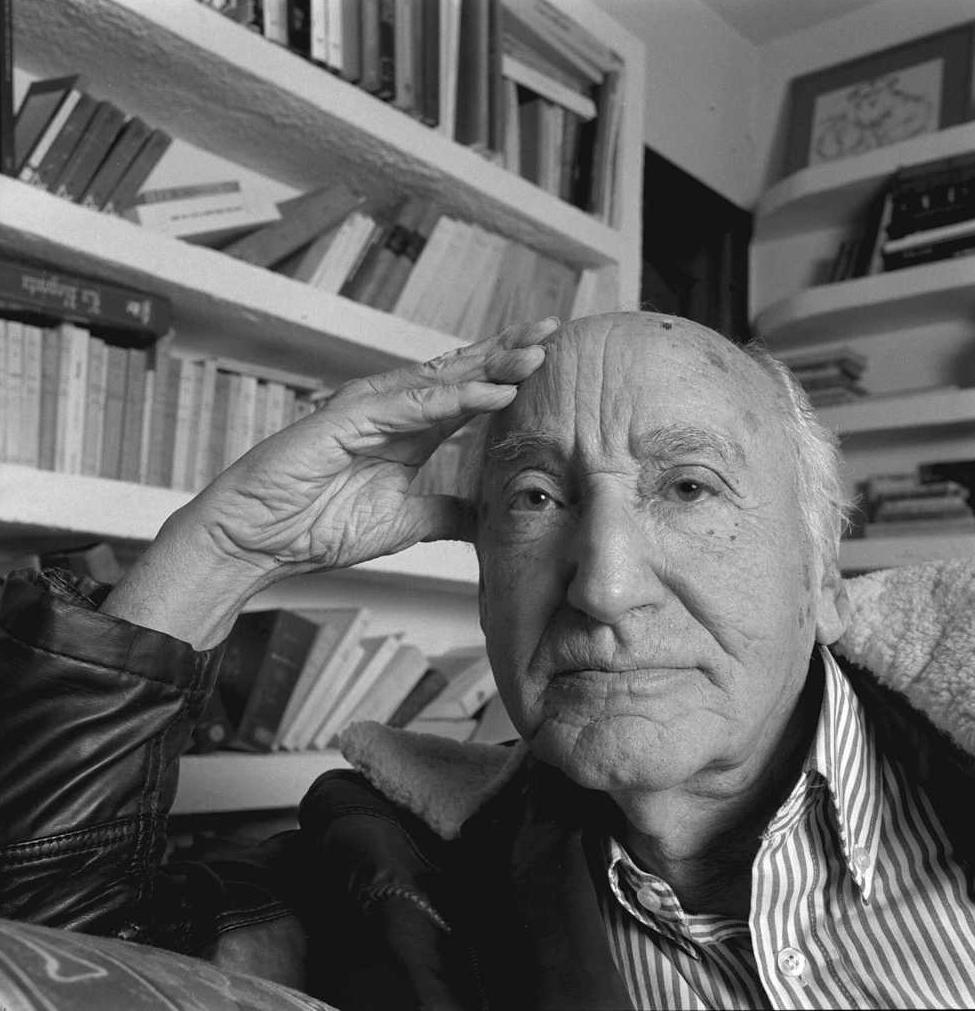
Bousoño was born in Boal, Asturias, in 1923. At the age of two his parents moved to Oviedo, where they spent their childhood and adolescence. He studied the first two years of the career of Philosophy and Letters in Oviedo and moved to Madrid at the age of nineteen to conclude them in 1946 at the Central University, today Complutense, with an extraordinary prize. At that same university he received his doctorate in 1949 with the first thesis in Spain on a writer still alive, Vicente Aleixandre, poet of the Generation of 27 later awarded the Nobel Prize for Literature (1977). His thesis was published with great success ( La poesía de Vicente Aleixandre , 1950) and is still considered today the best and most profound study of the poetry of this author. In 1951 he published with Dámaso Alonso, his great teacher and companion within the stylistic discipline, Seis calas en la expresión literaria española, his best known theoretical book, several times republished and expanded, Teoría de la expresión poética (1952). Among his fundamental works it is also worth mentioning The Poetic Irrationalism. (The Symbol) (1977), Poetic Superrealism and Symbolization (1978) and a very ambitious work that did not come to conclusion: Literary Epochs and Evolution (1981). He gathered
THE ORIGINALITY OF FUENTE OVEJUNA CARLOS BOUSOÑO
his complete poetry in 1998, revised under the title Spring of Death. He married Ruth, a Puerto Rican former student with whom he had two children, in 1976 and taught Spanish literature at several American universities (Wellesley, Smith, Vanderbilt, Middlebury, New York University, among others). He taught the subject of stylistics at the Complutense University of Madrid, of which he was in his last years professor emeritus. He won the Fastenrath Prize of the Royal Spanish Academy in 1952 and was appointed a full member of the same in 1979, delivering his entrance speech in 1980. A year earlier, he had won the National Essay Prize for Poetic Irrationalism and Symbolism
In 1990 he was awarded the National Poetry Prize for ''Metaphor of the lack of immunity'', a key book in his evolution from realism to symbolism and was named doctor honoris causa by the University of Turin. In 1993 he won the National Prize for Spanish Literature and in 1995 he received the Prince of Asturias Award for Letters. He was also an Honorary Fellow of the Hispanic Society of America and Honorary President of the Loewe Poetry Prize, one of the most important in Spain. He was also a finalist on two occasions for the Reina Sofía Prize for Ibero-American Poetry (May 1993 and June 1994) and in December 2000 he was a candidate for the Cervantes Prize, in which he was among the four finalists, an award for which he also competed in 1998, 2001 and 2002. For many years he was voted as the best professor of the Complutense University. He was also an outstanding lecturer. His classes at the Complutense University were always master classes that Bousoño said without looking at a single note. His fame as a teacher led to his classrooms to significant poets and writers who studied at the Complutense University.
Among his best friends in the literary field it is worth mentioning, apart from Vicente Aleixandre himself, whose archive he inherited, Francisco Brines, Claudio Rodríguez, Francisco Nieva, Mario Vargas Llosa, José Olivio Jiménez, and Giannina Braschi, among others. Throughout his life he maintained a close relationship of friendship with Vicente Aleixandre, from whom he received love correspondence that was not made public until his death. He died in Madrid on October 24, 2015 at the age of 92. At the time of his death he was the oldest scholar of the RAE.
INAEM. Ministerio de Cultura, 1993

FUENTE OVEJUNA 19 18 THEATRE FOR A NEW AUDIENCE 360° SERIES
Brenda Meaney (Pascuala), Ricardo Vázquez (Barrildo), Paco Lozano (Ortuño). Photo by Gerry Goodstein.
Ricardo Vázquez (Barrildo) and Ben Chase (Leonelo). Photo by Hollis King.
Photograph of Carlos Bousoño
DIALOGUES CUE GUITAR MUSIC: COMPOSING FOR FUENTE OVEJUNA
BY PADDY CUNNEEN
CUE GUITAR MUSIC: COMPOSING FOR FUENTE OVEJUNA PADDY CUNNEEN
Fuente Ovejuna and I still remember your music from it. We’re going to mount a production here, do you have any recordings of your music that you might share with us…”
What Jeffrey wasn’t taking account of was that, in 1989, we didn’t have the digital technology and mobile phones that have made recording engineers and photographers of us all. In those days we simply accepted that theatre was an ephemeral form, and that our work would drift off into the ether. Here today, gone tomorrow—as befits the philosophy of travelling players. However…What did remain was my hand-written music—as sketched out for the actors at the time—written in haste with a scratchy old fountain pen, on paper which now resembled some ancient papyrus scroll.
I scanned it anyway, and sent it off.
Jeffrey gets back to me,“Thanks for the music, would you be willing to talk to the director, Flordelino?” The invitation rekindled all the memories of the first version, details of the great play and our compelling production to come flooding back. “Yes. Of course I would…”
people of the town itself, it needed to be simple, heartfelt, raw and exuberant. Something that a highly developed musically technique could well undermine. I really wanted the actors who spoke text on stage to be the ones who played the music. The ensemble was the thing!
It had also been a principal aim of mine to honour a Spanish saying which I’d heard. “The song of the piano is a discourse. The song of the cello is an elegy. The song of the guitar is… a song.” In any company of actors you will find surprising levels of skills in all manner of subjects, and music is usually a great lurking talent in an ensemble. Within that first company were two actors with very useable guitar skills. We were up and running! Next we needed a musical frame of reference which would present the King and Queen as being at the very top tier of this society.
Music Director Paddy Cunneen reflects on his work on two Fuente Ovejuna's, an ocean and thiry-four years apart.
1989 was an incredible year to live through. Following the agitation of a democratic movement in Poland, Communism suddenly collapsed, state by state, in Eastern Europe. Unbelievably, the dominoes ran on to the old Soviet Union itself. The seemingly impossible was happening as popular uprisings rattled long established powers. Even the Berlin Wall was breached—not by soldiers but by civilians. And in China too, there were civil uprisings in Tiananmen Square. It’s hard to convey how incredible it felt to be living at a time when the world seemed to be spasming into unimaginable change.
Against this backdrop, my own personal life was blooming. I discovered the personal happiness of being a father, and professionally I was suddenly invited to The National Theatre in London to work on the music for a production of a play I had never heard of.
The play somewhat uncannily, also presented a backdrop of huge societal and political upheaval. It featured a new state being born, and at war with itself. Within that, was also a more personal story centred on the basic human need for love and respect, in a society in which brutality and repression has become institutionalised.
The play was, of course, Fuente Ovejuna, written around 1612, about events in 1476. Yet here it was now, resonating loudly with the astonishing political events of 1989. I became intensely attached to it. We all did. I remember the commitment with which we all worked on it through rehearsals, and in conversation afterwards. It became incredibly important to everyone involved. Fuente Ovejuna is a play that changes a person’s perspective. It is an absolute masterpiece. So…

Fast forward far too many years and I receive an intriguing email. It’s from a certain Jeffrey Horowitz, at Theatre For A New Audience in Brooklyn—“Dear Paddy, many years ago I saw a production at the National Theatre in London which affected me greatly. It was
The music for that first production was composed to be essentially simple. It was written to allow an ensemble of actors to play it and sing it from within the performance itself. The acting ensemble was a key concept in the Cheek By Jowl approach—we didn’t want any agency bigger than the actor on stage. No huge technical effects and a clear, uncluttered design were the hallmarks of our work. The aim being that the actors were the primary point of engagement for the audience. It’s a philosophy that I carry to this day—I try to avoid recordings in productions, and always aim to integrate live music with live action in front of a live audience.
On arrival at the National, I was surprised to be introduced to a flamenco guitarist. He had hastily been pre-booked to do the show, and was a superb player. Unfortunately had been engaged ahead of any discussions with Declan Donnellan, the director, or with me. So my first, unfortunate, job was to explain that the guitarist was actually in many ways too good, and sadly wouldn’t really fit in our production. (Don’t worry, he still got paid…)
We wanted to music such as might be performed by a group of people who spent their lives working the soil. Folksy and Spanish in its modality, yes, but like the
It has to be said that we had a much bigger cast available for the show in London, as was the norm then—it was a different era in that sense too. So The National were able to employ understudies to cover company indispositions, and that allowed us to find understudies with musical skills. We were able to audition ‘extra’ actors who could, in addition to being understudies, play the trumpet. Finding two such actors, we put them in the show as soldiers, and they blasted out a short fanfare every time Ferdinand and Isabella entered or exited.
With the cast resources in place, I wrote the music during the course of rehearsals. That still remains an approach I like to take. It puts me through the same process as the actors, keeps me in touch with the production concept, stops me from being compositionally indulgent music and keeps me focused on writing music with a specific dramatic function. In that regard, I was very happy to work on two songs in particular. The first being the "Sparrow, Song," in which Pascuala sings in an early scene. In it she discovers the parallels in the behaviour of ungrateful sparrows and ungrateful lovers. Songs which develop character and advance the story are always good songs to write. The guitar supported the sincerity of the actor’s singing, and the lyrics came alive. And then there was the difficult nature of the lyrics to "Maiden from the Hill." It tells of a knight relentlessly pursuing a young woman, and clearly parallels the central story of the Commander in
FUENTE OVEJUNA 21 20 THEATRE FOR A NEW AUDIENCE 360° SERIES THE TEARS OF DENIS
JOHNSON AARON GILBREATH
Kenneth De Abrew (Mengo), Barzin Akhavan (Esteban). Photo by Gerry Goodstein.
CUE GUITAR MUSIC: COMPOSING FOR FUENTE OVEJUNA PADDY CUNNEEN
the village. It seems an extraordinarily inappropriate song for celebrating a marriage, and it’s placed squarely in the wedding scene. I took the view that the song is a kind of statement from the collective unconsciousness of the village. It induces contemplation, not celebration, and in that way has a very particular dramatic function.
The people of Fuente Ovejuna are, essentially, in denial regarding the Commander’s appalling behaviour towards the women. They are all trying to live with the devil, of course, and this has the effect of compelling them to find ever more self deluding ways of tolerating his increasing levels of coercive control and abuse. I felt an introspective setting would have the power to release the suppressed awareness of how things really are with the Commander. (It’s significant that the song is interrupted by the Commander—he is almost conjured up by it!)
Whilst that first production seemed particularly relevant to the political upheavals of the time, it did also horrify our audiences with its portrayal of the brutality suffered by the women. In our current frame of reference, #MeToo can only amplify that particular strand of the play for a contemporary audience. It has rightly become one of
the most important cultural issues of our time—and one which Lope articulated with incisive and compassionate clarity 400 years ago.
Much has changed since the London production, although Fuente Ovejuna still refuses to feel dated. And so to TFANA in 2023.
The smaller cast size, but no lesser company talent, has put pressure on the music realisation in this production. Whilst there are several actors in this company who play guitar extremely well, throughout rehearsals they always seemed to be in other scenes, or doing a high speed costume change at the critical moment when their skills could have been used on stage. We don’t have a system of understudies here, who might relieve the pressure on the cast, and it became apparent after a 10 days of rehearsal that we wouldn’t be able to deliver the music in exactly the same way as before.
However, we were fortunate enough to be able to bring in Jo Brook as a musical presence onstage with her guitar. So the song of the guitar is very much still a song, and keeps the music of the village live in this production.
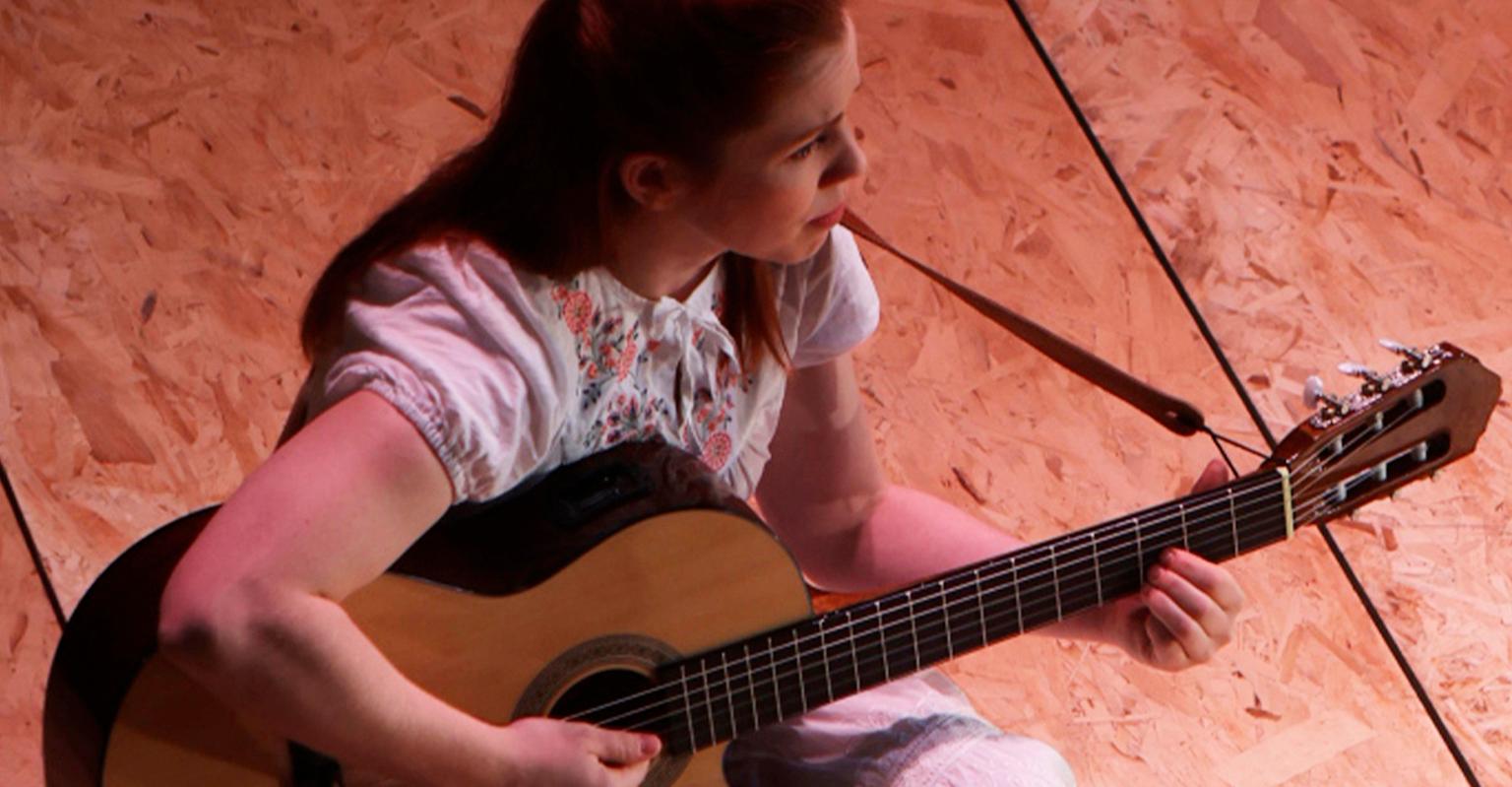
CUE GUITAR MUSIC: COMPOSING FOR FUENTE OVEJUNA PADDY CUNNEEN
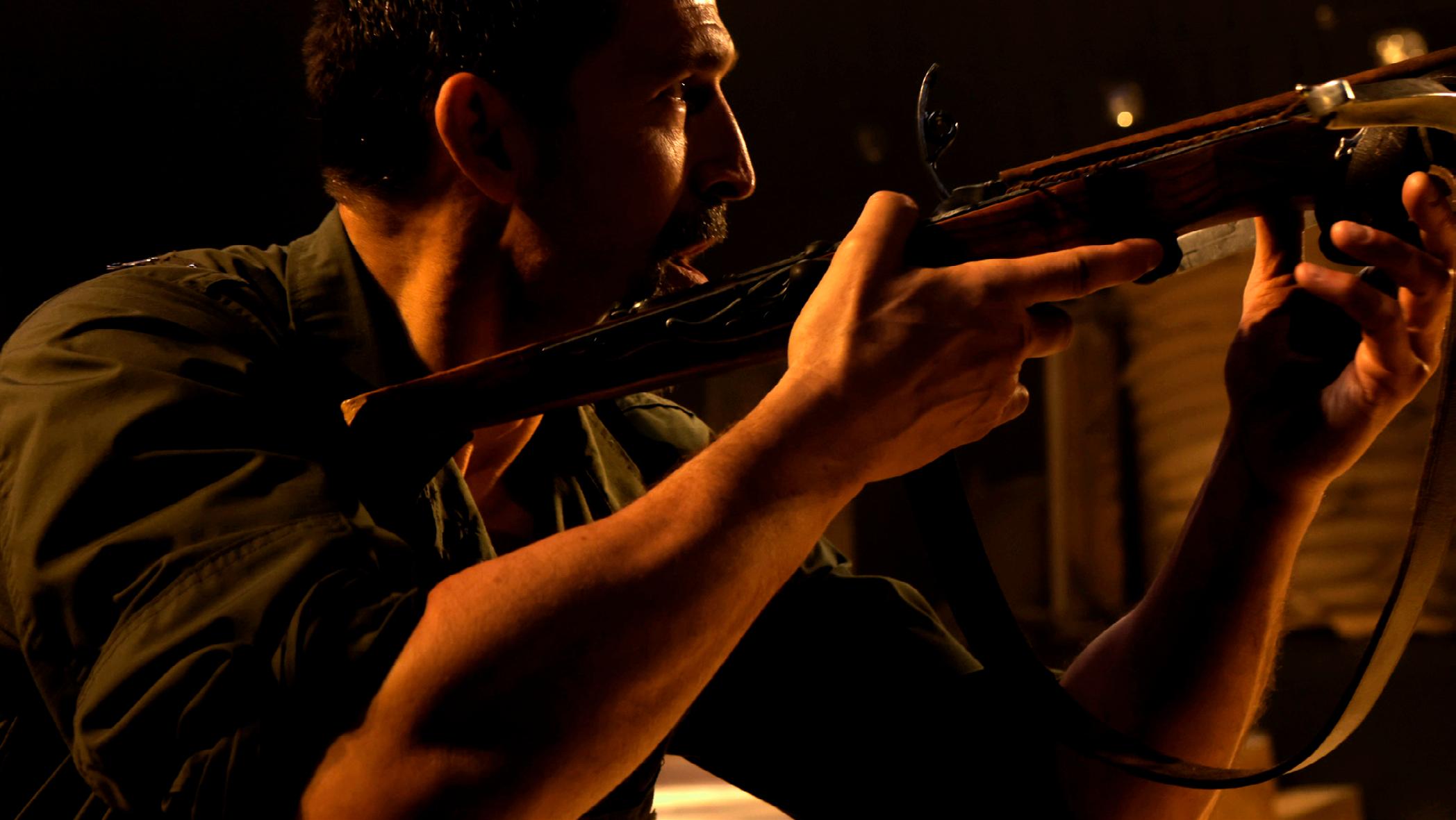
As far as the military strand of the play goes, a new approach was needed for similar reasons. I’ve opted to put drums on stage, and this definitely intensifies the threatening presence of the billeted soldiers. The drums are played live whenever possible, but yes, you will also hear a little recorded support for them. The result is a more “orchestral” feel to the play here in Brooklyn. And then, without trumpets, we unapologetically offer the great singing voice of one of our cast members to raise the roof for the Ferdinand and Isabella.
It has been an intriguing experience to re-visit the play here at TFANA. I have to say that shifts in cultural concerns, with the more articulate perspective on the ordeals faced by women, have majorly re-focused the work. I feel is a testament to the evolution of our cultural thinking.
Of course the earlier production addressed the treatment of women, how could it not? But perhaps not in such strikingly clear terms as now, and certainly the audience of the time were not so actively attuned to the issue. However, that production was likewise of its time, and chimed with this issue, and with contemporaneous concerns for world events. The music, I hope, has helped tell the story for each.
Finally, I feel that the diversity in these productions demonstrates the genius and broad vision of Lope de Vega. Fuente Ovejuna will hold a mirror up to our nature, and reflect our concerns, for a long time to come.
Cue guitar music….his touring company La Barraca, eliminated the kings altogether to focus on the town’s revolt, royal authority hardly appears all-powerful. Instead, the kings must yield to Fuente Ovejuna’s collective strategy, and rule with the consent of the ruled.
Politically trenchant yet full of humor and pastoral idealism, Fuente Ovejuna transcends its immediate historical context to serve as a lasting meditation on the power of community. Yet the play would not have such staying power if it were a simple manifesto. Instead, it forces us to ask hard questions about how and where justice must be located. Is violence the only alternative to complacency? Can collective action be mobilized without appealing to the most atavistic of motives? Is it possible, or even essential, to negotiate with corrupt regimes? Countless adaptations and productions have located these questions in different contexts, from maquiladoras to supermarkets, with the rise of undemocratic forces and the #MeToo movement offering a newly resonant backdrop for us today..
FUENTE OVEJUNA 23 22 THEATRE FOR A NEW AUDIENCE 360° SERIES
Jo Brook ( Musician ). Photo by Hollis King.
Jonathan Cake ( Commander ). Photo by Hollis King.
DIALOGUES FUENTE OVEJUNA: A RENAISSANCE MORALITY PLAY OF HUMAN RIGHTS
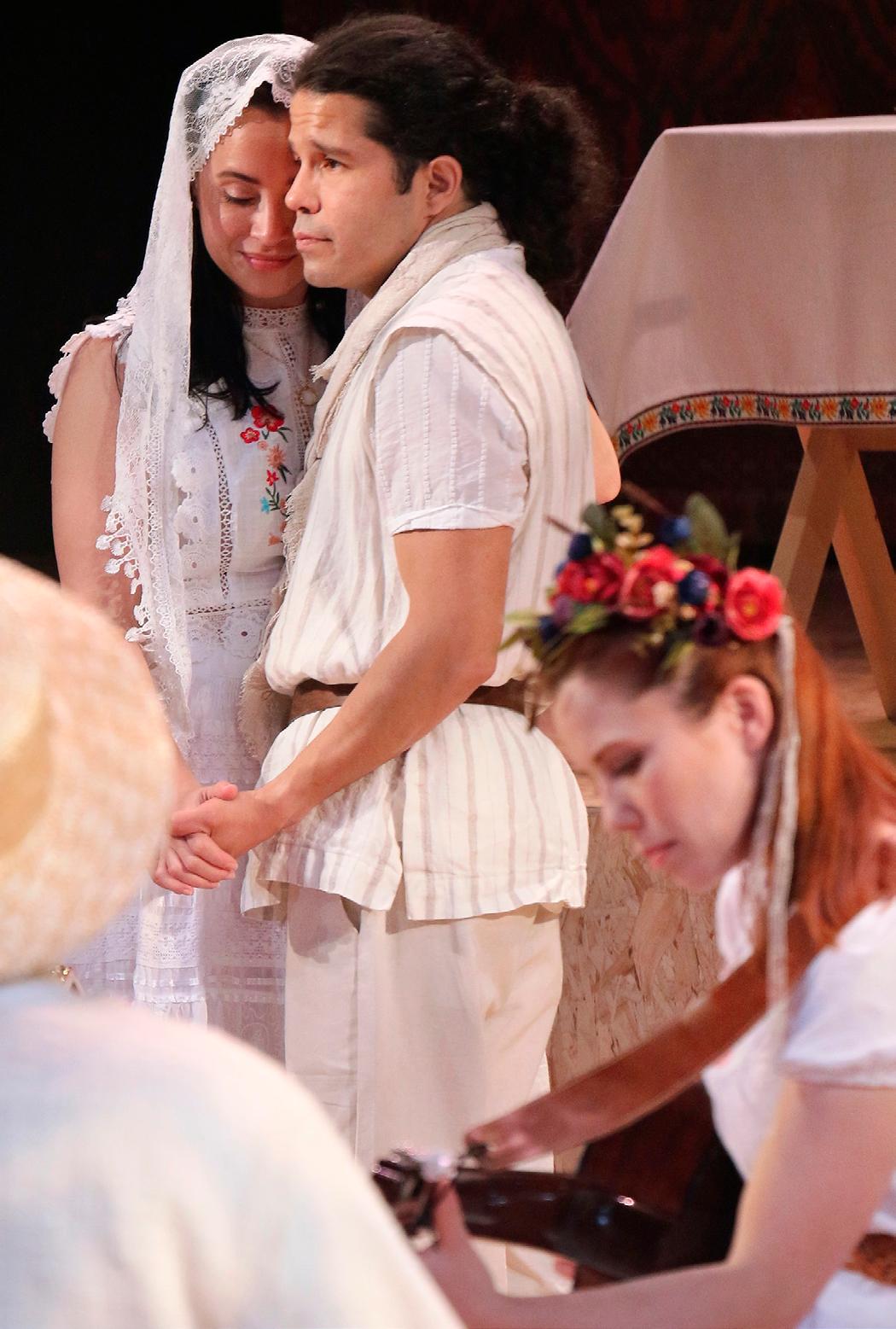 BY DOUGLAS PARKER, UCLA
BY DOUGLAS PARKER, UCLA
Theater has always been a powerful weapon for political critique. Agents of authority have a long and dramatic history as targets of the playwright’s pen. The classic conditions for this dynamic is dominant authoritarian power and a single subversive individual facing off. This is exactly what you find in Renaissance Spain and the playwright Lope de Vega. His Fuente Ovejuna takes this essential paradigm and ratchets it up a notch. Instead of tilting at the windmills of established power as a single however insightful critique, this play summons a universe of allies and endows them with a superpower that would become the lynchpin of civilization in our Modern Era. This power, voiced in its infancy through this play, is the simple notion that human beings have inherent rights. These Human Rights, as they come to be known, are the beating heart of Lope de Vega’s masterpiece.
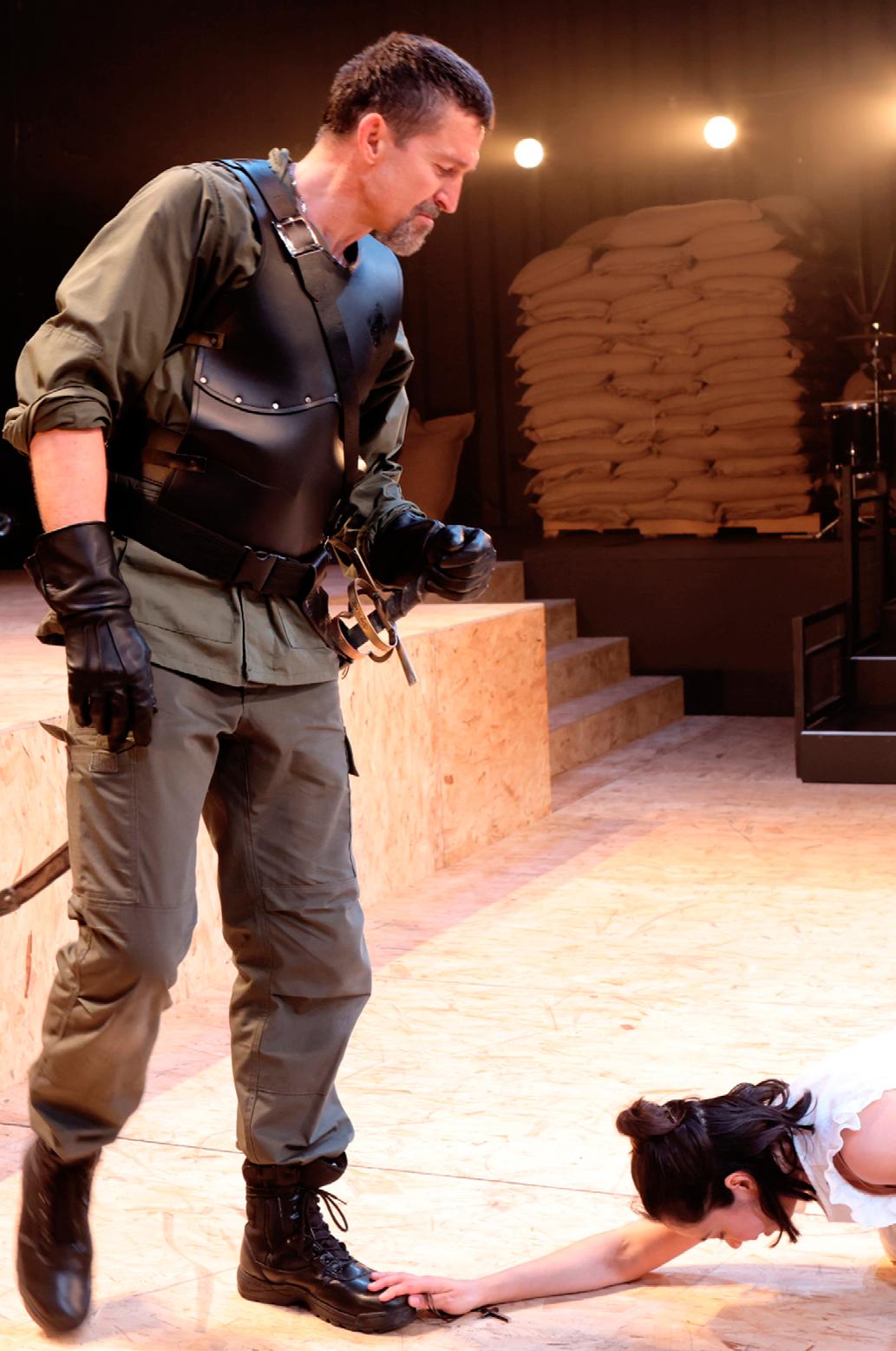
The conflict between establishment authority and the value of individuals themselves finds quick representation in this story of ordinary people trying to live their lives. Laurencia demonstrates a remarkable sense of the privileges she enjoys as an individual within her small-town society. In the masterfully-crafted Act 1 Scene 2, she playfully trades wit with the boys in a virtuoso command of language. She and Frondoso offer twinned spotlight speeches that turn on the distinctions between words and their meaning, between the surface representation and its undercurrent reality. The pairing of these two bears all the marks of courtship, but the flirtation can distract from the insidious conclusion that these two people, one young woman and one young man, are nobody’s inferior. The surface representation of this scene is of young lovers inching closer; the undercurrent reality is that they are equal to one another and subservient to none. The recognition of universal basic human rights thus begins in the guise of puppy love.
The blunt force of this argument hits when the p lay takes a remarkably darker turn. When Laurencia enters in Act 3 Scene 1, she’s “desmelenada,” or ‘disheveled’. It’s unclear what she’s been through but it’s obvious
that she’s been roughed up in some capacity. We don’t know if she’s been tortured. We don’t know if she’s been raped. We know she’s been through something, so much so that her own father doesn’t recognize her when she walks in the room. She’s changed. But just ahead of town meeting at the local courthouse to discuss the community’s conflict with the Commander, she comes up and says “Dejadme entrar, que bien puedo en consejo de los hombres; que bien puede una mujer, si no a dar voto a dar voces.” Essentially, ‘I have a right to speak,’ which is a radical thing to say. There were no individual rights in that society. But even moreso, she is telling that room full of men that ‘I have a right to speak even in this seat of power.’
FUENTE OVEJUNA : A RENAISSANCE MORALITY PLAY... DOUGLAS PARKER
directive of the Early Modern Age. So, Laurencia raises the issue: ‘Why can’t a woman say something in public? Why can’t a woman vote? Why can’t a woman make decisions for herself on matters that pertain so intimately to her?… and be respected for it?’ That is a very radical move indeed.
Arguably, Fuente Ovejuna doesn’t have an exclusively feminist agenda at play here. This is certainly also just another example of social hierarchy. Women have generally been relegated to the lower tier of the traditional gender binary. In this play about challenging hierarchies, about the pressures and rage that builds up because of these entrenched constructions of social power, the gender hierarchy is an obvious example. Lope de Vega may be
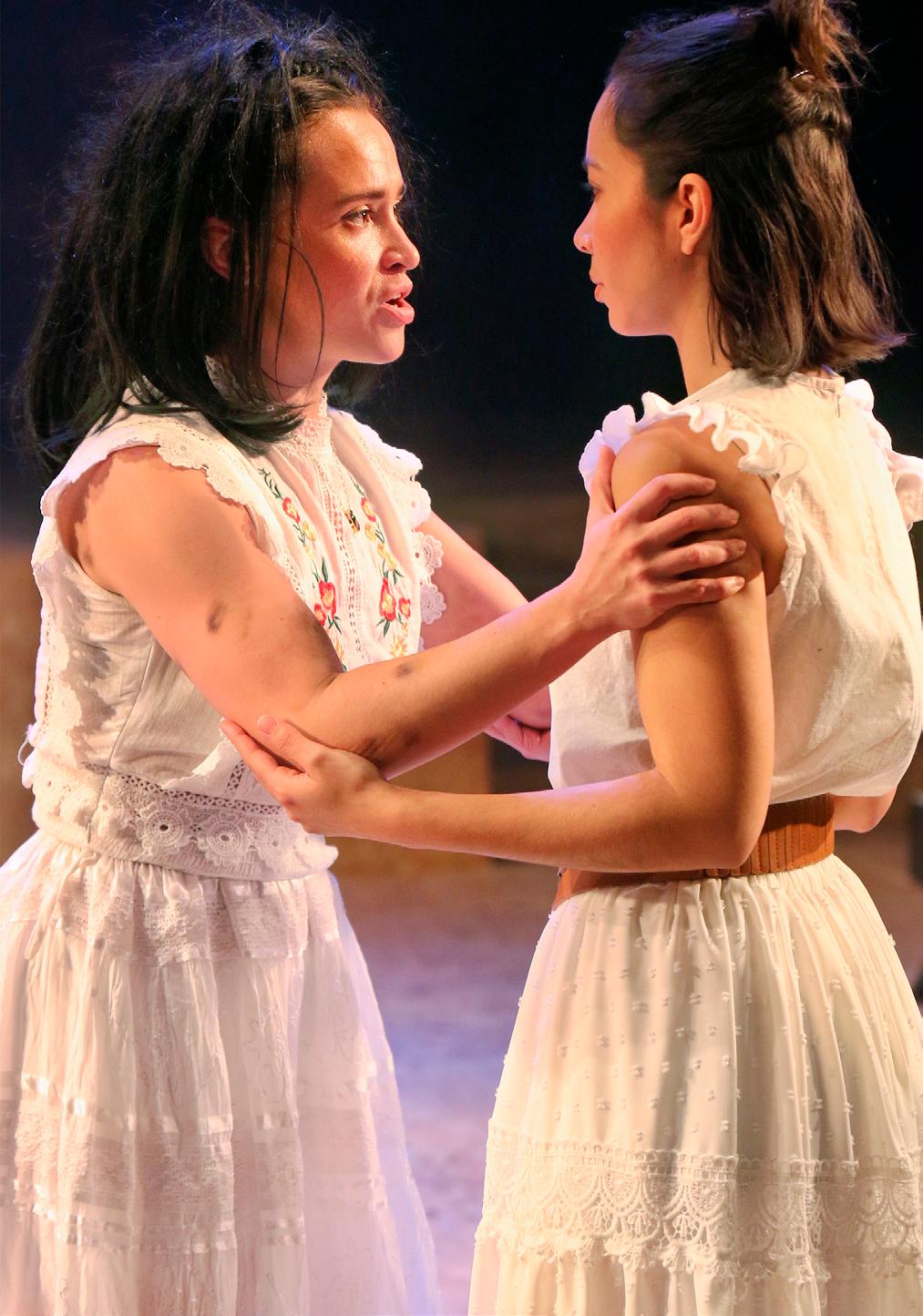
By saying this, she is asserting that her humanity itself deserves precedence over established tradition. She claims that she has a right to speak based solely on the fact that she is a human being. And this right supersedes the traditions of our community that so long ago consigned women to silence as members of society.
A core element of the Renaissance is that element of challenging established tradition and authority. The rebirth of classical Greco-Roman culture that marked the 14th through 17th Centuries marks a deep investment in long-standing habits of culture and custom. However, this same reflexive reverence of tradition is counterbalanced in the true Renaissance spirit by a critique of traditions. Humanist Reason rises to prominence as the engine of that spirit. The ability to think and speculate and pose the essential question ‘Do things have to be this way?’ is the prime
FUENTE OVEJUNA 25 24 THEATRE FOR A NEW AUDIENCE 360° SERIES
Carmen Zilles ( Laurencia ), Octavia Chavez-Richmond ( Jacinta ). Photo by Gerry Goodstein.
Carmen Zilles ( Laurencia ), Carlo Albán ( Frondoso ), Jo Brook ( Musician ). Photo by Gerry Goodstein.
Jonathan Cake ( Commander ), Octavia Chavez-Richmond ( Jacinta ). Photo by Hollis King.
FUENTE OVEJUNA : A RENAISSANCE MORALITY PLAY... DOUGLAS PARKER
deliberately pushing a specifically feminist critique, but certainly this can also be simple synecdoche for traditional culture at large. While blasting away at the major institutions running Spain in the Renaissance Era, Fuente Ovejuna saves some critical artillery for the broader practices of traditional culture.
Equally arguably, however, Lope de Vega may have chosen this critique of patriarchy as a deliberate misdirection. In Spain, criticizing the royal court and the Catholic Church is a risky proposition at any point in history, let alone during the later eras of the Spanish Inquisition. The explicit details of Fuente Ovejuna ’s story and characterizations are about as bold as any art can be expected to go under those conditions. But artists of all ages have learned the arts of plausible deniability. To this end, the feminist case may be a stalking horse that helps dispel the
case against Fuente Ovejuna by laughing off any prosecutable revolutionary intent as a whole. In the long tradition of Aristophanes, Molière, and Charlie Chaplin, Lope de Vega could be letting the powers that be scoff at the absurdity that such an outlandish play could ever be taken seriously.
And yet, strictly feminist or broadly Humanist, the pitch it makes for Human Rights is indisputable. Woman or not, Laurencia stands up in that municipal sphere and demands to be heard. She specifically cites her identity not as an individual woman in a particular circumstance, but as a representative of women as a group: “que bien puedo en consejo de los hombres; que bien puede una mujer.” Thus, all women have this inherent right to be heard. This extends the audacity from the claim of individual rights to collective rights. If women have the right to assert themselves as a
FUENTE OVEJUNA : A RENAISSANCE MORALITY PLAY... DOUGLAS PARKER
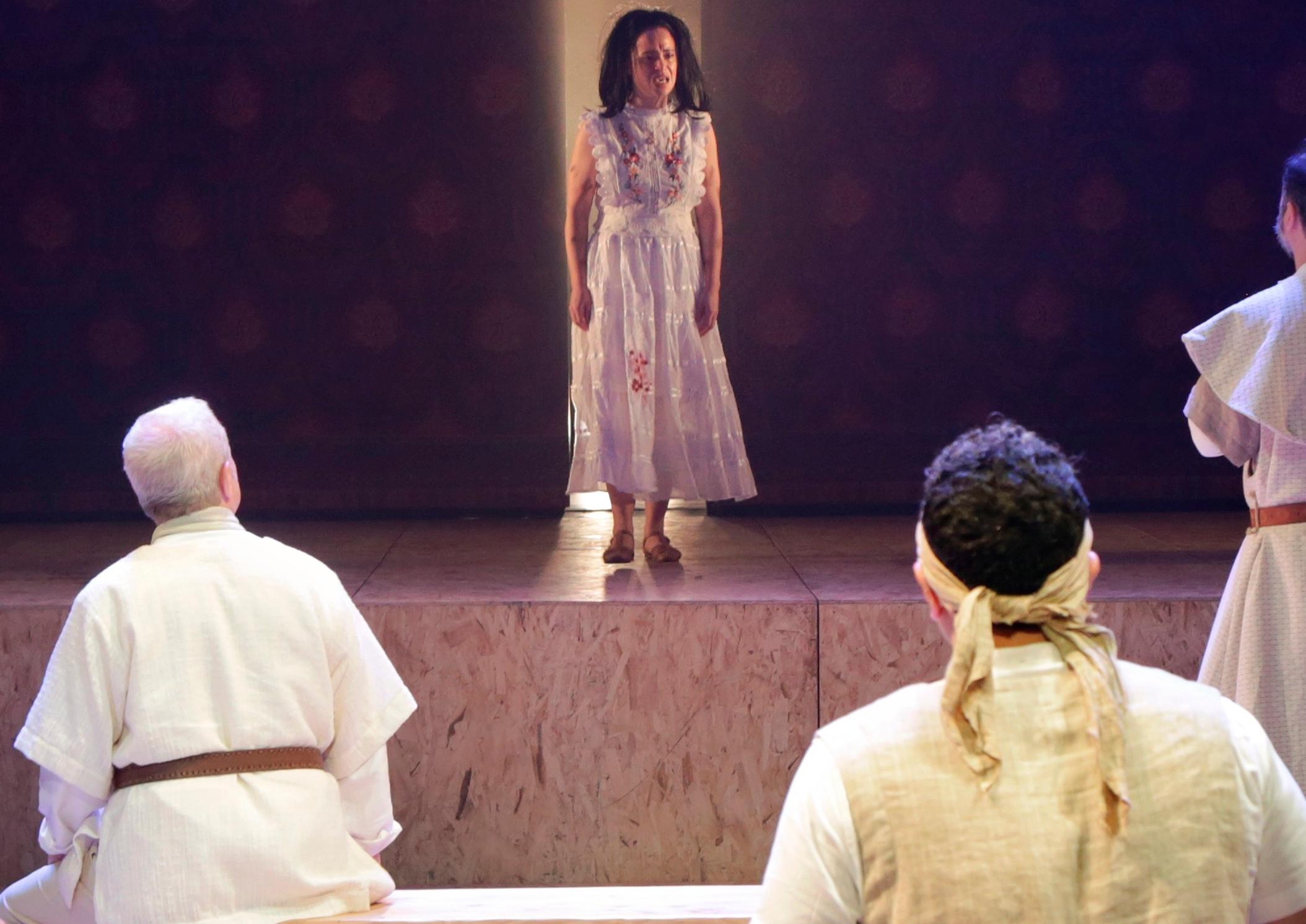

group against their oppressors in a Patriarchal society, then any group must logically bear the same rights against whatever oppressor may threaten. Conversely, any group can only have full integrity of collective rights if it is composed of individuals enjoying those same protections. So, by making her argument as a woman speaking to that room of small-town authority, Laurencia is positing that all women are endowed with that identical right. By asserting recognition of her dignity as a human being, she demands that recognition for all as well. By claiming this right in a small municipal courthouse, she demands it in the face of any authority regardless of scale or entrenched tradition. The play is a staged 17th Century Universal Declaration of Human Rights.
Watch or read Fuente Ovejuna for its drama, its comedy, its characters, and its action. Watch it for the
forum it provides for transcendent performances. But watch or read it for the way it lights a spark within the darkness of political hierarchy. Laurencia makes a great heroine over the course of three acts on the bare floor of any theater stage; but her personification of Human Rights soars through time and space to grant the world a vision of the ineradicable value inherent in individual people everywhere. .
Douglas Parker teaches Literature and Writing at Baruch College and the New York Institute of Technology. He holds graduate degrees from the University at Albany, Fordham, and CUNY, and is pursuing a Phd in Comparative Literature at the CUNY Graduate Center. He shares lectures on YouTube and serves on the Board of the Port Summer Show, a non-profit community theater program now in its 5th decade.
FUENTE OVEJUNA 27 26 THEATRE FOR A NEW AUDIENCE 360° SERIES
Carmen Zilles ( Laurencia ). Photo by Gerry Goodstein.
Stephen Berenson ( Juan Rojo ), Kenneth De Abrew ( Mengo ), Barzin Akhavan ( Esteban ), Brenda Meaney ( Pascuala ), Brian McEleney ( Alonso ), Carmen Zilles ( Laurencia ). Photo by Gerry Goodstein.
THE PRODUCTION CAST AND CREATIVE TEAM
BARZIN AKHAVAN ( Esteban/Master’s Advisor ). Broadway: Network, The Kite Runner . NYC: CSC ( Macbeth ), The Public/WNYC ( Richard II ), Waterwell ( Hamlet ). Select regional: Seattle Rep, Guthrie, Arena, Huntington, Baltimore Center Stage, A.C.T. SF, Theatre Calgary, Folger, CATF, Lookingglass, Mixed Blood, Cincinnati Playhouse, Merrimack Rep, Virginia Stage, five seasons at Oregon Shakespeare Festival, four seasons at Lake Tahoe Shakespeare Festival, Colorado Shakespeare Festival. Television: “The Blacklist,” “Chicago Med,” “Girls5eva,” “Smash,” “Law & Order: Criminal Intent.” Film: Inappropriate Behavior (upcoming), The Jew of Malta, Anniversary .
CARLO ALBÁN ( Frondoso ). Broadway: Sweat (Theatre World Award for an Outstanding Broadway debut). OffBroadway: Romeo y Julieta, References to Salvador Dalí (The Public Theater); Tamburlaine (TFANA); A Small, Melodramatic Story, Intríngulis (Labyrinth). Regional: Fandango (La Jolla); Whitelisted (CATF); The River Bride, Much Ado About Nothing, Timon of Athens (OSF); A Parallelogram, Lydia (CTG); Night of the Iguana (Guthrie). Film: Mile 22, Hurricane Streets, 21 Grams, Whip It, Margaret . TV: “Sesame Street,” “Oz,” “Thicker Than Blood,” “Prison Break,” “The Night Of,” “Black Bird.” Member of Labyrinth Theater Company.
REBECCA AZENBERG (Stage Manager). LaGuardia High School, School of American Ballet, Columbia University. Dance/film: Pennsylvania Ballet, Black Swan, Christopher Wheeldon’s Swan Lake . Performance: Edinburgh Festival, the Kennedy Center, New York City Center. Broadway/regional/tours: Wicked first national tour, Waitress first national tour, Waitress, Chicago, Mr. Saturday Night, Guys & Dolls at the Kennedy Center.
Octavia Chavez-Richmond (Jacinta), Ricardo Vázquez (Barrildo), Jonathan Cake ( Commander ), Barzin Akhavan ( Esteban ), José Espinosa ( Father Oliver), Brenda Meaney (Pascuala),
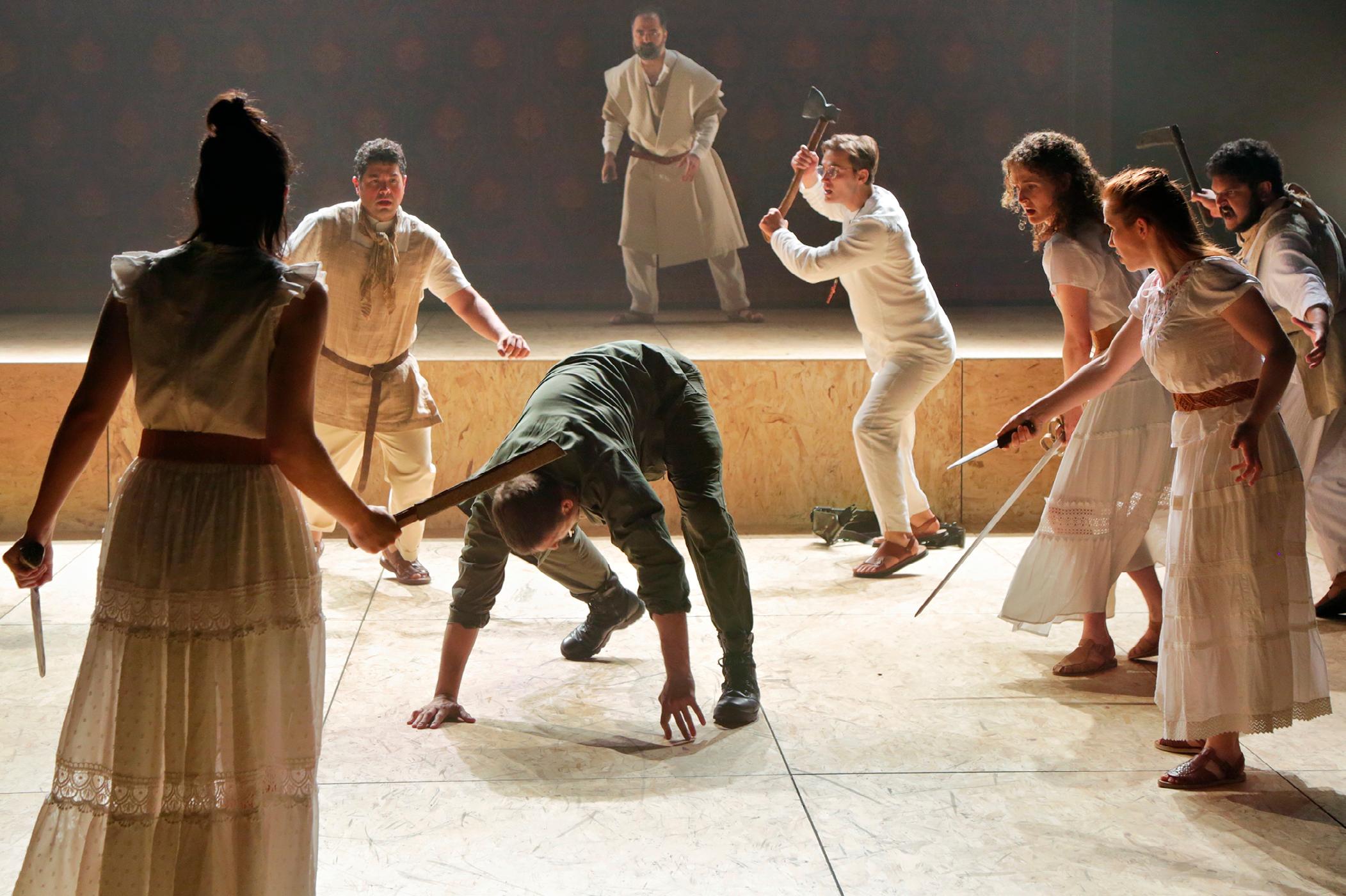
THE PRODUCTION CAST AND CREATIVE TEAM
JACK BERENHOLTZ (Captain Flores). Off-Broadway: Nantucket Sleigh Ride (Lincoln Center). New York: Nightmare Dream (FringeNYC), Progeny (Riverside Theatre), Antigone (Connelly Theatre), Henry IV.I (Extant). Regional: Cleveland Playhouse, Gulfshore Playhouse, Chautauqua Theatre Company, Williamstown, Schoolhouse Theater. TV: “Evil,” “Law & Order: SVU,” “Tommy,” “The Good Fight,” “The Deuce.” Film: Simchas & Sorrows, The Black Monk, Bandito (TriBeca Film Festival). Education: NYU grad acting (MFA). Big thanks to the team at TalentWorks. @jackberenholtz .
STEPHEN BERENSON he/him (Juan Rojo/First Alderman). 1978 NY debut: Dead End . Thirty years with Trinity Rep Resident Acting Company (Puck, Feste, Fool, Shylock, Witch, Willy Loman, Grendel, Fagin, Bellomy/ Fantasticks, Schultz/Cabaret, four seasons as Scrooge); 16 summers with Bread Loaf Acting Ensemble (Friar, Dogberry, Polonius), the Kennedy Center, Dallas Theater Center, more. First director/acting faculty/founding director, Brown/Trinity MFA programs. Current: faculty, Middlebury College, Oxford. Partner/husband for 46 years: Brian McEleney. stephenberenson.com
JO BROOK (Musician/Ensemble) is a Montana native and NYC-based HOH actor, musician and advocate. She is the founder of the all-female bluegrass collective The Snowy Mountain Sisters. Acting credits include Silent Sky (Asolo Rep), October Sky (Universal Stages), The Goree All-Girl String Band (NYMF and The Drama League), Wild Fire (Denver Center) and Once (Cape Playhouse). jo-brook.com
JONATHAN CAKE (Commander Fernando Gomez). Broadway: Medea (Theatre World Award), Cymbeline (Lincoln Center), The Philanthropist. Off-Broadway: Coriolanus, Much Ado About Nothing (Calloway Award for Best Classical Performance), Antony and Cleopatra and Measure for Measure. London highlights include Baby Doll at the National Theatre and the West End (Barclays Theatre Award for Best Actor), Coriolanus at Shakespeare’s Globe. TV/film include “Five Days at Memorial,” “Stargirl,” “Desperate Housewives,” “Extras,” “Doll & EM,” Brideshead Revisited, “Camping,” among others. Jonathan is the creator and host of the “Stage Door Jonny” podcast.
BEN CHASE (King Ferdinand of Aragon/Leonelo). Off-Broadway/regional: The Far Country (Atlantic Theater Company); Mondo Tragic, I am Soul (National Black Theatre); Romeo and Juliet, Nothing Gold Can Stay (Old Globe); Spunk (Classical Theatre of Harlem); May 39th (Drama League). Film: Audrey’s Children (upcoming), Dee Rees’ The Last Thing He Wanted (Netflix), A Call to Spy (IFC Films) and A Shot Through the Wall . TV: “The Thing About Pam,” “Law & Order: Organized Crime,” “Monsterland,” “Transparent,” “Mysteries of Laura,” “Difficult People,” “Undocumented.” MFA: Brown/Trinity.
OCTAVIA CHAVEZ-RICHMOND ( Jacinta/Queen Isabella of Castile ) is thrilled to make her TFANA debut!
Octavia is an actor/writer/storyteller who uses theatre and film to disrupt hierarchy, racism and misogyny. Selected theatre: Pride and Prejudice (Long Wharf Theatre), Between Riverside and Crazy (SpeakEasy Stage Company), Yoga Play (Syracuse Stage/Geva Theatre), Last Ship to Proxima Centauri world premiere (Portland Stage Company), Marisol (Trinity Repertory Company). Selected film: Free Guy, Knives Out, From Nowhere (SXSW). Training: Brown/Trinity MFA acting.
KENNETH DE ABREW ( Mengo ). Measure for Measure (TFANA), As You Like It (Baruch PAC). Regional: Petrol Station (the Kennedy Center), Guards at the Taj (Woolly Mammoth Theatre Company), Indian Ink (American Conservatory Theater). Television: “New Amsterdam,” “Girls5eva,” “Jes-sica Jones,” “Atlanta,” “The Detour,” “Un-breakable Kimmy Schmidt,” “Gotham,” “Awkwafina,” “WeCrashed,” “Helpsters.” Film: Someone Great, This Is Where I Leave You, Submission . Education: MFA LSU; BA Ohio Wesleyan University; attended Trinity College, Kandy, Sri Lanka. kennethdeabrew.com. Instagram: @kennethdeabrew
FUENTE OVEJUNA 29 28 THEATRE FOR A NEW AUDIENCE 360° SERIES
Jo Brook (Ensemble), Kenneth De Abrew (Mengo) Photo by Gerry Goodstein.
THE PRODUCTION CAST AND CREATIVE TEAM
MARIA BELLA DiVITTORIO (Assistant Stage Manager). Broadway: Mr. Saturday Night. Off-Broadway: Lessons in Survival: 1971 (Vineyard Theater). Regional: Paperboy (Manhattan School of Music), Black Like Me (Chautauqua Theater), Mr. Saturday Night (Barrington Stage Company) and Ella and Her Fella Frank (Virginia Rep). She received her BFA in stage management from UNCSA in 2021. Much love to her cats, Pretzel and Chucky.
JOSÉ ESPINOSA he/him ( Grand Master Rodrigo Tellez Giron/Farmer/Father Oliver/Boy ) is a Cuban-Jewish actor, filmmaker and teaching artist. Broadway: Take Me Out (u/s). Off-Broadway: Los Complicados (EST). Regional: Curve of Departure (Chester), The Other World, The Meal (Yale Cabaret). Educational theatre favorites include The Tempest, The Seagull, Seven Spots on the Sun, Death of Yazdgerd, Twelfth Night and Completely Outta Fucks directed by Chris Bayes. MFA: Yale School of Drama. Thank you Mom and Dad.
PACO LOZANO ( Sergeant Ortuño/Don Manrique ). NYC theatre: Much Ado About Nothing, Mother Courage (The Public Theater). Regional theatre: The Crucible, The Road to Ruin, The Millionairess (Asolo Rep); Androcles & The Lion (Milwaukee Chamber). Film: Spoiler Alert, Bushwick . TV: “Manifest,” “Jessica Jones,” “Law & Order: SVU,” “The Good Wife,” “Madam Secretary,” “Bridge and Tunnel.”
BRIAN McELENEY he/him ( Alonso/Second Alderman ). Trinity Rep Resident Company: over 100 productions (actor: Richard II, Richard III, King Lear, Malvolio, Cassius, Felix Unger, Prior Walter, Scrooge. Director: The Grapes of Wrath, All the King’s Men, Hamlet, Whitney White’s By the Queen . Playwright: Jane/Johnny Eyre, A Tale of Two Cities . Founding director, Brown/Trinity MFA programs (with Stephen Berenson) and head of theatre at Middlebury College’s Bread Loaf School of English.
THE PRODUCTION CAST AND CREATIVE TEAM
BRENDA MEANEY ( Pascuala ). Tom Stoppard’s Indian Ink (Roundabout); Incognito (Manhattan Theatre Club); Party Face (New York City Center); Neil Labute Short Play Festival; Little Gem (Irish Repertory Theatre); The Mountains Look Different, The New Morality (The Mint). Regional: Venus in Fur, The Hard Problem (A.C.T.); Queens (La Jolla Playhouse); Caucasian Chalk Circle, Owners (YRT); And a Nightingale Sang... (Westport Country Playhouse). Film/television: Fear the Night, There’s Always Hope , “FBI: Most Wanted,” “For Life,” “Hell on Wheels,” “Love/Hate” (RTÉ). BA, Trinity College Dublin; MFA, Yale School of Drama.
RICARDO VÁZQUEZ ( Barrildo/Cimbranos ). Broadway: The Inheritance . NYC: Superstitions (The Pool Plays); Richard III, As You Like It (Hudson Valley Shakespeare Festival); Bordertowns (HERE). Regionally: Guthrie Theater ( The Royal Family , Rachel Chavkin dir.), Alabama Shakespeare Festival, Children’s Theater Company, among others. TV: “The Other Two” (HBO), “In an Instant” (ABC), “M@dabout TV.” Film: Nina of the Woods, Farmer of the Year, Gets Good Light, Death to Prom . More: Ricardo-Vazquez.com .
CARMEN ZILLES ( Laurencia ). At TFANA: Fefu and Her Friends , directed by Lileana Blain-Cruz. Off-Broadway includes Epiphany (Lincoln Center Theater), Scenes From a Marriage (NYTW), Small Mouth Sounds (Signature Theatre), Little Women (Primary Stages), Chimichangas and Zoloft (Atlantic), Adoration of the Old Woman (INTAR) and others. Film/TV: “Bel Canto” (starring Julianne Moore), “Pimp” (starring Keke Palmer), “Law & Order: Organized Crime,” “FBI,” “Blue Bloods.” Training: Yale School of Drama. For JKDC, and for Mama.
FLORDELINO LAGUNDINO ( Director ) is a director, actor, producer and educator. He is the producing artistic director of Theater Alaska. His directing credits include Macbeth, A Midsummer Night’s Dream (Theater Alaska); Aubergine (Park Square Theatre); FOB (Drama League); Sweeney Todd, Doubt, Yellowman, Cedar House, Animals Out of Paper (Perseverance Theatre); Sweeney Todd (Juneau Symphony); Flipzoids, True West, Shakespeare’s R&J (Generator Theater Company). He participated in the TFANA Actors and Directors Project and received the SDCF Sir John Gielgud Classical Directing Fellowship and Drama League NY Directing Fellowship. Lagundino holds an MFA in directing from Brown University/Trinity Repertory Company and an MFA in acting from University of Texas at Austin. lagundino.com
AFSOON PAJOUFAR ( Scenic Designer ) is a New York-based designer of stage and environment for plays, operas and other live performances. Recent works include Molière’s Dom Juan (Fisher Center at Bard Summer-Scape 2022), English (Studio Theatre), Lady M (HeartBeat Opera), [MORNING//MOURNING] (PROTOTYPE), Mad Forest (Theatre for a New Audience and Fisher Center at Bard), Word.Sound.Power (Brooklyn Academy of Music), Paper Pianos (EMPAC), Will You Come With Me (The Play Company), Icons/Idols: In the Purple Room (New Ohio Theatre), s.i.n.s.o.f.u.s (Harvard University) and The Silence (Massachusetts Institute of Technology). She is a proud member of USA829. afsoonpajoufar.com
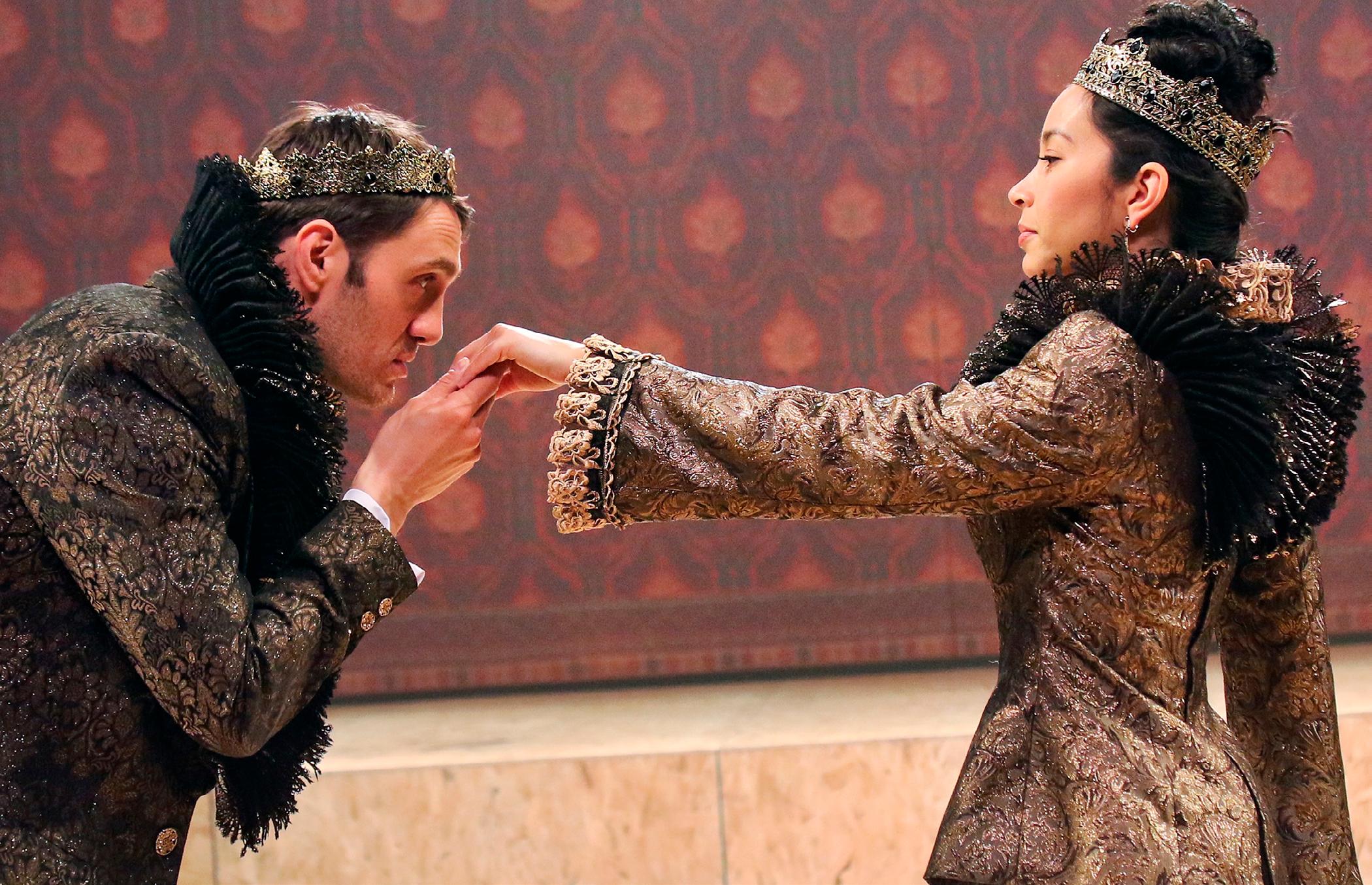
LINDA CHO ( Costume Designer ). Broadway: Summer, 1976; POTUS; Take Me Out; Grand Horizons; The Great Society; The Lifespan of a Fact; Anastasia (Tony nom); A Gentlemen’s Guide to Love & Murder (Tony Award); The Velocity of Autumn . Off-Broadway: Twilight, Cambodian Rock Band (Signature Theatre); Kristina Wong Sweatshop Overlord, Endlings (NYTW). Regional: A Thousand Splendid Suns (A.C.T.); DDLJ (The Old Globe); Noir (Alley Theatre). Opera: Samson et Dalila (Met Opera), Turandot (Washington National Opera). Other: TDF’s Irene Sharaff Young Master Award, Ruth Morely Design Award; advisory committee member of the American Theatre Wing. MFA, Yale School of Drama. lindacho.com
JIYOUN CHANG ( Lighting Designer ). Broadway credits: KPOP Broadway, For Colored Girls Who Have Considered Suicide/When the Rainbow Is Enuf (Tony nom), Slave Play (nomination of Tony, Drama Desk, Henry Hewes). Recent credits: Ride the Cyclone (Arena Stage), The Factotum (Chicago Lyric Opera), Bina’s Six Apples (Suzi Bass
FUENTE OVEJUNA 31 30 THEATRE FOR A NEW AUDIENCE 360° SERIES
Octavia Chavez-Richmond (Queen Isabella), Ben Chase (King Ferdinand). Photo by Gerry Goodstein.
THE PRODUCTION CAST AND CREATIVE TEAM
Award), Marys Seacole (Henry Hewes nom), The World Is Round (Obie Award), The Public, Roundabout, NYTW, MCC, Signature, ATC, Guggenheim, Berkeley Rep, CalShakes, Guthrie, The Old Globe, OSF.
PADDY CUNNEEN ( Composer ) is a composer, director and playwright. He is an associate director of Cheek by Jowl Theatre Company. His work as theatre composer runs to more than 250 productions in Europe, USA, Canada and Japan. He also has several film score credits. This is the second time he has been involved in a production of Fuente Ovejuna , and his first time working at TFANA here in Brooklyn—which he loves!
BRIAN BROOKS ( Choreographer ), a Guggenheim Fellow in choreography, was recently the first-ever choreographer in residence at Chicago’s Harris Theater for Music and Dance. His New York City-based group, the Moving Company, has been presented by BAM’s Next Wave Festival, The Joyce Theater, NY City Center and many others. Brooks has choreographed several productions with Theatre for a New Audience, beginning ten years ago with the building’s inaugural performance of A Midsummer Night’s Dream , directed by Julie Taymor.
ANDREW WADE (Voice Director). The Royal Shakespeare Company: 1987–2003 (voice assistant), 1990–2003 (head of voice). Since 2003: The Acting Company, Guthrie Theater, Stella Adler Studio (master teacher voice and Shakespeare). Currently: TFANA (resident voice and text director), The Public Theater (director of voice), Juilliard (adjunct faculty Drama Division). Broadway: Harry Potter and the Cursed Child Parts One and Two (U.S. head of voice and dialect), King Lear with Glenda Jackson (voice coach), Matilda (director of voice and national tour), A Christmas Carol and tour, A Bronx Tale the Musical. Film: Shakespeare in Love. Workshops and lectures worldwide. Fellow of Rose Bruford College.
JONATHAN KALB (Resident Dramaturg) is professor of theatre at Hunter College, CUNY, and is TFANA’s resident dramaturg. The author of five books on theatre, he has worked for more than three decades as a theatre scholar, critic, journalist and dramaturg. He has twice won the George Jean Nathan Award for Dramatic Criticism and has also won the George Freedley Award for an outstanding theatre book from the Theatre Library Association. He often writes about theatre on his TheaterMatters blog at jonathankalb.com.
J. DAVID BRIMMER (Fight Director), Fight Master SAFD, SAFD (2023 Obie Award, Sustained Excellence in Fight Direction), has choreographed some stuff (selected Broadway: Pass Over, Hangmen, American Buffalo, Spring Awakening, The Lieutenant of Inishmore, Grace, Speed-the-Plow, Thérèse Raquin, Long Day’s Journey Into Night; NY premieres: Socrates, Fairview, Is God Is, Yen, Gloria, An Octoroon, Blasted, Bethany, Blackbird, Bug, Killer Joe). “Walk cheerfully over the world, answering that of God in everyone.”—G. Fox
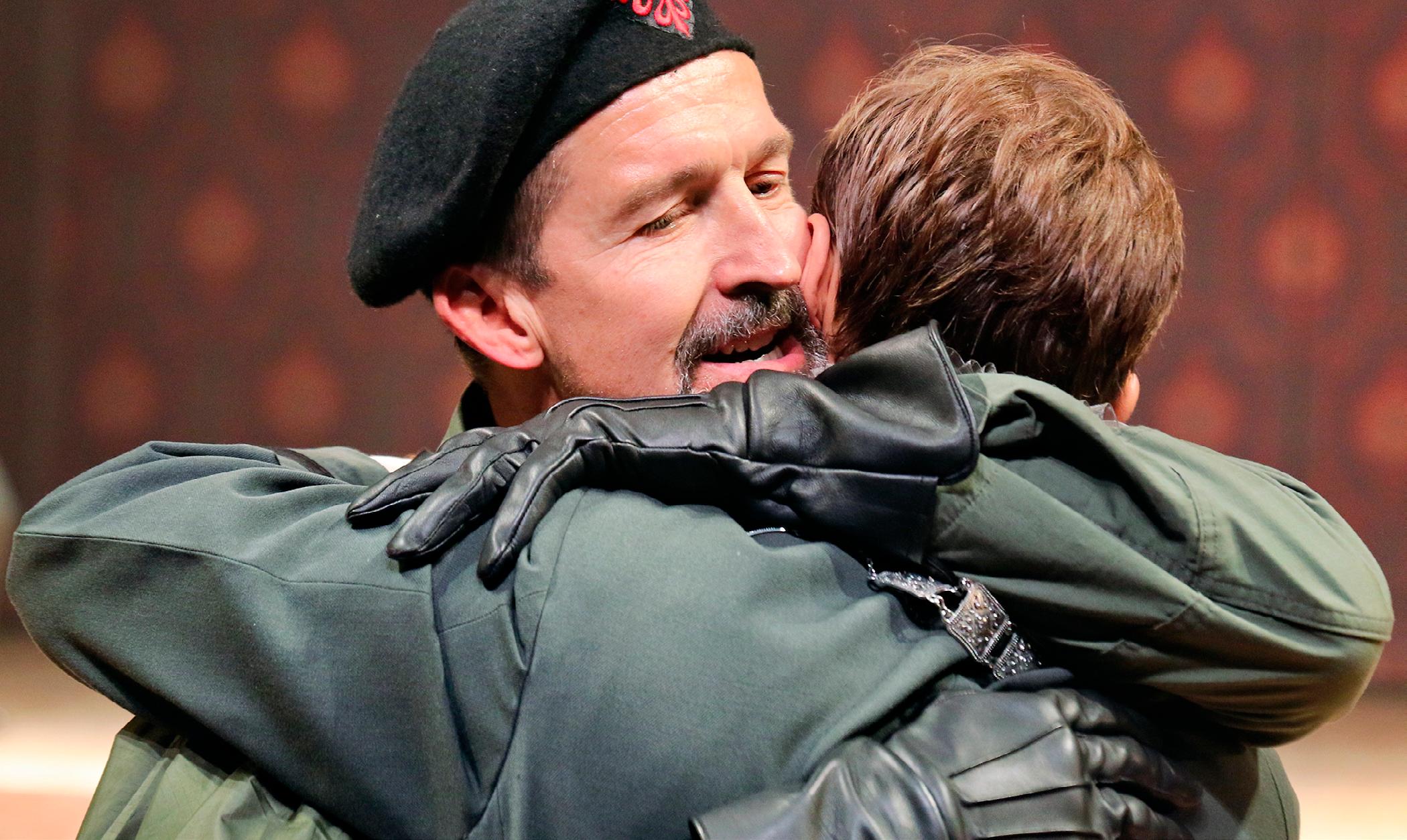
DAN O’DRISCOLL ( Intimacy Director/Associate Fight Director ). Initial workshop with Intimacy Directors International in 2019. Afterwards, attended 150+ hours of classes primarily with Theatrical Intimacy Education (TIE) and Intimacy Directors and Coordinators (IDC), completing pathway to certification, level two in 2021. In 2022-23: intimacy director on ten projects, including four shows at Music Theatre of Connecticut (AEASPT) and returning as intimacy director/actor advocate for the Maryland Renaissance Festival. Thirty-plus years’ experience as a fight director (SAFD CT/FD). swordandtherose.com
JUSTIN COX ( Props Supervisor ) is a Texas-born, New York-based art director and production designer, specializing in television, film and live performances. Coming from a lineage of artists and artisans, Justin learned the value of hands-on creation. His unique aesthetic and appreciation for the functionality of objects and environments have served Lady Gaga, Broadway and the greater storytelling community.
FIVE OHM PRODUCTIONS ( Sound System Design ) specializes in video and sound design for theatre and live performances. Our recent sound design credits include Mamma Mia! with Marymount School and A Midsummer
THE PRODUCTION CAST AND CREATIVE TEAM
Night’s Dream at Portland Center Stage. Video design credits include Fahrenheit 451 at the Hippodrome State Theatre and Cambodian Rock Band at the Alley Theatre. We are delighted to be working with TFANA on Fuente Ovejuna ! The Fuente Ovejuna sound design team includes Ryan Hall, Travis Wright and Cheyenne Chao.
BLAKE ZIDELL & ASSOCIATES (Press Representative) is a Brooklyn-based public relations firm representing arts organizations and cultural institutions. Clients include St. Ann’s Warehouse, Playwrights Horizons, Signature Theatre, Soho Rep, National Sawdust, The Kitchen, Performance Space New York, PEN America, StoryCorps, Symphony Space, the Fisher Center at Bard, Peak Performances, Irish Arts Center, the Merce Cunningham Trust, the Onassis Foundation, Taylor Mac, Page 73, The Playwrights Realm, PlayCo and more.
THEATRE FOR A NEW AUDIENCE . Founded in 1979 by Jeffrey Horowitz, this is Theatre for a New Audience’s (TFANA) 43rd season. Through its productions of Shakespeare and other new plays, humanities initiatives and programs in NYC public schools, TFANA creates adventurous dialogues with diverse audiences. TFANA has produced 33 of Shakespeare’s 38 plays alongside an international mix of classical and contemporary drama; promotes ongoing artistic development through its Merle Debuskey Studio Fund; and in 2001, growing from a collaboration with Cicely Berry, the Royal Shakespeare Company’s director of voice, TFANA became the first American theatre company invited to bring a production of Shakespeare to the RSC.
ACTORS' EQUITY ASSOCIATION (“Equity”), founded in 1913, is the U.S. labor union that represents more than 50,000 actors and stage managers. Equity seeks to foster the art of live theatre as an essential component of society and advances the careers of its mem bers by negotiating wages and working conditions and providing a wide range of benefits including health and pension plans. Actors’ Equity is a member of the AFL-CIO and is affiliated with FIA, an international organization of performing arts unions. #EquityWorks
FUENTE OVEJUNA 33 32 THEATRE FOR A NEW AUDIENCE 360° SERIES
Jonathan Cake (Commander). Photo by Gerry Goodstein.
THE PRODUCTION CAST AND CREATIVE TEAM
STAFF FOR FUENTE OVEJUNA
Technical Director........................................... Joe Galan
Assistant Director..................................... Allison Benko
Production Assistant................. Margaret Fortuna Yassky
Assistant Scenic Designer..................... Matthew Buttrey
Associate Costume Designer.....Isabella Fernandez Rasdal
Assistant Lighting Designer.......................... Sam Weiser
Casting Assistant....................................Krystal Sobaskie
Costume Supervisor..............................Sylvana Hardesty
Stitcher.................................................... Sharone Malka
Costume Shopper.............................Deijah Martin-Valle
Hair, Wig and Makeup Consultant............Rachael Geier
Covid-19 Safety Managers...............Ryan Duncan-Ayala, Spence Logan
Wardrobe Supervisor...................................... Ali Caruso
Dressers....................................Kim Kaiser, Khari Walser
Props/Deck Carpenter.....................Tristan Viner-Brown
Light Board Programmer and Operator......Paul Kennedy
Sound Board Operator.................................... Zen Perry
Production Electrician..........................Jimmy Dewhurst
Production Audio...................................... Travis Wright
Assistant Production Audio....................Cheyenne Chao
Electricians.......................... Erin Bulman, Darcy Burke, Rhylke Caputo, Parker Damm, Abi Harris, Melissa Ore, Sydnee Peterson, Bonnie Chi-Kit Puk, Will Rossiter,
THEATRE FOR A NEW AUDIENCE LEADERSHIP


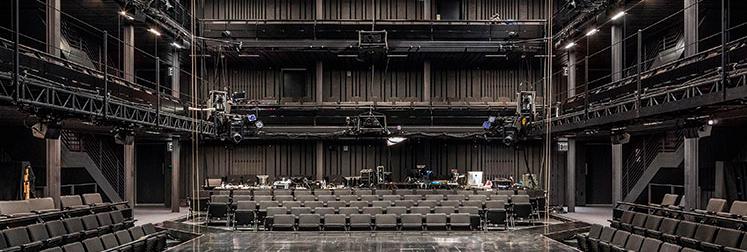
Zachary Saunders, Noah Stape, Archer Swietek, Sam Weiser
Audio Crew.......................Rudy Bearden, Scott Fetterman, Steven Fine, Noah Hornick, Daniel Massey, Jose Rivas
Lead Carpenter.....................................................Leon Axt
Carpenters..................................Cory Asinofsky, Leon Axt, Sebastian Braccia, Stuart Chapin, Jules Conlon, Mark D’Agostino, Helen Hylton, Frann McCrann, Thomas Moore, Mike Mroch, Teddy Mueller, Tobias Segal, Henry Witherow-Culpepper
Lead Rigger................................................ Cory Asinofsky
Riggers...................................... Cory Asinofsky, Leon Axt, Joe Galan, Tobias Segal
Truck Drivers...................Jeorge Condors, Eduardo Tobont
CREDITS
Production audio services and additional audio equipment provided by Five Ohm. Lighting equipment provided by Hayden Production Services. Costumes built by Arel Studio, Brooks/Masline.
JEFFREY HOROWITZ (Founding Artistic Director) began his career in theatre as an actor and appeared on Broadway, Off-Broadway and in regional theatre. In 1979, he founded Theatre for a New Audience. Horowitz has served on the panel of the New York State Council on the Arts, on the board of directors of Theatre Communications Group, the advisory board of the Shakespeare Society and the artistic directorate of London’s Globe Theatre. Awards: 2003 John Houseman Award from The Acting Company, 2004 Gaudium Award from Breukelein Institute, 2019 Obie Lifetime Achievement and TFANA’s 2020 Samuel H. Scripps.
DOROTHY RYAN (Managing Director) joined Theatre for a New Audience in 2003 after a ten-year fundraising career with the 92nd Street Y and Brooklyn Museum. Ryan began her career in classical music artist management and also served as company manager and managing leader for several regional opera companies. She is a Brooklyn Women of Distinction honoree and serves as treasurer of the Downtown Brooklyn Arts Alliance.
JEREMY BLUNT (General Manager). Prior to joining TFANA in 2023, Jeremy was the managing director of the Sierra Repertory Theatre in Sonora, California. Before that, he was on the general management team at Broadway Asia where he worked on DreamWorks’ Kung Fu Panda Spectacular Live and served as the contract affairs coordinator at the Stage Directors and Choreographers Society. MFA: performing arts management, Brooklyn College. MBA, bachelor of science in business administration, California Baptist University. He proudly served in the U.S. Army and Air National Guard, retiring in 2021 after holding multiple leadership positions.
FUENTE OVEJUNA 35 34 THEATRE FOR A NEW AUDIENCE 360° SERIES
Polonsky Shakespeare Center. Photo © David Sundberg/Esto.
Samuel H. Scripps Mainstage.
Photo by Francis Dzikowski/OTTO.
Jonathan Cake (Commander), Brenda Meaney (Pascuala). Photo by Hollis King.
ABOUT THEATRE FOR A NEW AUDIENCE
About Theatre for a New Audience
BOARD OF DIRECTORS
Board Chair
THEATRE FOR A NEW AUDIENCE MAJOR SUPPORTERS
STAFF
Founding Artistic Director
Jeffrey Horowitz
Managing Director Dorothy Ryan
General Manager Jeremy Blunt
Director of Institutional Advancement
James J. Lynes
Finance Director Mary Sormeley
Education Director Lindsay Tanner
Capital Campaign Director
George Brennan
Director of Marketing & Communications

Eddie Carlson
Facilities Director Rashawn Caldwell
Production Manager Brett Anders
Company Manager Molly Burdick
Theatre Manager Lawrence Dial
Box Office Manager Allison Byrum
Marketing Manager Angela Renzi
Associate Director of Development
Sara Billeaux
Artistic Associate Peter J. Cook
Education Coordinator Emma Griffone
Coordinator, Administration & Humanities|Studio Programming
Nadiya Atkinson
Finance Associate Harmony Fiori
Associate to the Founding Artistic Director
Allison Benko
Grants Associate Emmy Ritchey
Development Associate Olivia Laskin
Development Associate Gavin McKenzie
Facilities Associate Rafael Hurtado
New Deal Program Coordinator Zhe Pan
TFANA Teaching Artists
Albert Iturregui-Elias, Elizabeth
London, Erin McCready, Kea Trevett, Matthew Dunivan
House Managers
Regina Pearsall, Adjani Reed, Nancy Gill Sanchez
Press Representative
Blake Zidell & Associates
Resident Director Arin Arbus
Resident Casting Director Jack Doulin
Resident Dramaturg Jonathan Kalb
Resident Distinguished Artist
John Douglas Thompson
Resident Voice and Text Director
Andrew Wade
TFANA COUNCIL OF SCHOLARS
Tanya Pollard, Chair
Jonathan Kalb, Alisa Solomon, Ayanna Thompson
Founded in 1979 by Jeffrey Horowitz, the mission of Theatre for a New Audience is to be home for Shakespeare and other contemporary authors. The Theatre is dedicated to the ongoing search for a living, human theatre and forging an immediate exchange with an audience that is always new and different from the last one. With Shakespeare as its guide, the Theatre builds a dialogue that spans centuries between the language and ideas of Shakespeare and diverse authors, past and present. An internationally respected producer, the Theatre develops and mounts productions that examine and illuminate the contemporary significance of classic plays and modern dramatic masterworks. In addition to its world-class productions, the Theatre engages its community through free Humanities programs for general audiences, extensive creative development opportunities for artists, and the largest indepth arts in education programs to introduce Shakespeare and classic drama to New York City Public School students.
Theatre for a New Audience Education Programs
Theatre for a New Audience is an award-winning company recognized for artistic excellence. Our education programs introduce students to Shakespeare and other classics with the same artistic integrity that we apply to our productions. Through our unique and exciting methodology, students engage in hands-on learning that involves all aspects of literacy set in the context of theatre education. Our residencies are structured to address City and State Learning Standards both in English Language Arts and the Arts, the New York City DOE’s Curriculum Blueprint for Teaching and Learning in Theater, and the New York State Common Core Learning Standards for English Language Arts. Begun in 1984, our programs have served more than 135,000 students, ages 9 through 18, in New York City Public Schools city-wide.
A Home in Brooklyn: Polonsky Shakespeare Center
Theatre for a New Audience’s home, Polonsky Shakespeare Center, is a centerpiece of the Brooklyn Cultural District.
Designed by celebrated architect Hugh Hardy, Polonsky Shakespeare Center is the first theatre in New York designed and built expressly for classic drama since Lincoln Center’s Vivian Beaumont in the 1960s. The 27,500 square-foot facility is a unique performance space in New York. The 299-seat Samuel H. Scripps Mainstage, inspired by the Cottesloe at London’s National Theatre, combines an Elizabethan courtyard theatre with modern theatre technology that allows the stage and seating to be arranged in seven configurations. The facility also includes the Theodore C. Rogers Studio (a 50-seat rehearsal/performance studio), and theatrical support spaces. The City of New York-developed Arts Plaza, designed by landscape architect Ken Smith, creates a natural gathering place around the building. In addition, Polonsky Shakespeare Center is also one of the few sustainable (green) theatre in the country, with LEED-NC Silver rating from the United States Green Building Council.
Now with a home of its own, Theatre for a New Audience is contributing to the continued renaissance of Downtown Brooklyn. In addition to its season of plays, the Theatre has expanded its Humanities offerings to include lectures, seminars, workshops, and other activities for artists, scholars, and the general public. When not in use by the Theatre, its new facility is available for rental, bringing much needed affordable performing and rehearsal space to the community.
Robert E. Buckholz
Vice Chair
Kathleen C. Walsh
President Jeffrey Horowitz
FoundingArtisticDirector
Vice President and Secretary Dorothy Ryan
Managing Director
Executive Committee
Alan Beller
Robert E. Buckholz
Constance Christensen
Jeffrey Horowitz
Seymour H. Lesser
Larry M. Loeb, Esq.
Philip R. Rotner
Kathleen C. Walsh
Josh Weisberg
Members
F. Murray Abraham*
Arin Arbus*
John Berendt*
Bianca Vivion Brooks*
Ben Campbell Robert Caro*
Sharon Dunn*
Riccardo Hernandez*
Kathryn Hunter*
Dana Ivey*
Tom Kirdahy*
Harry J. Lennix*
Catherine Maciariello*
Audrey Heffernan Meyer*
Alan Polonsky
Dorothy Ryan
Joseph Samulski*
Daryl D. Smith
Doug Steiner
Susan Stockel
Michael Stranahan
John Douglas Thompson*
John Turturro*
Frederick Wiseman*
*Artistic Council
Emeritus
Francine Ballan
Sally Brody
William H. Burgess III
Caroline Niemczyk
Janet C. Olshansky
Theodore C. Rogers
Mark Rylance*
Monica G.S. Wambold
Jane Wells
Even with capacity audiences, ticket sales account for a small portion of our operating costs. The Theatre expresses its deepest thanks to the following Foundations, Corporations, Government Agencies and Individuals for their generous support of the Theatre’s Humanities, Education, and Outreach programs.
The 360° Series: Viewfinders has been made possible in part by a major grant from the National Endowment for the Humanities: Exploring the Human Endeavor. Any views, findings, conclusions, or recommendations expressed in this Viewfinder, do not necessarily represent those of the National Endowment for the Humanities.
A Challenge Grant from the NEH established a Humanities endowment fund at Theatre for a New Audience to support these programs in perpetuity. Leading matching gifts to the NEH grant were provided by Joan and Robert Arnow, Norman and Elaine Brodsky, The Durst Organization, Perry and Marty Granoff, Stephanie and Tim Ingrassia, John J. Kerr & Nora Wren Kerr, Litowitz Foundation, Inc., Robert and Wendy MacDonald, Sandy and Stephen Perlbinder, The Prospect Hill Foundation, Inc., Theodore C. Rogers, and from purchasers in the Theatre’s Seat for Shakespeare Campaign, 2013 – 2015.

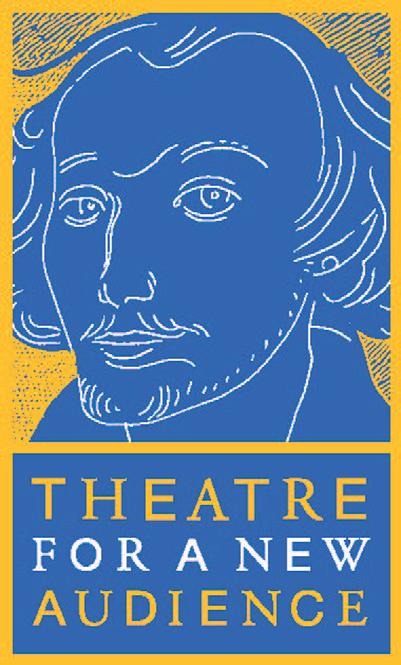
Theatre for a New Audience’s Humanities, Education, and Outreach programs are supported, in part, by The Elayne P. Bernstein Education Fund. For more information on naming a seat or making a gift to the Humanities endowment, please contact James Lynes, Director of Institutional Advancement, at 212-229-2819 x29, or by email at jlynes@tfana.org
Deloitte and Bloomberg Philanthropies are the 2022-2023 Season Sponsors.
Theatre for a New Audience’s productions and education programs are made possible, in part, with public funds from the National Endowment for the Humanities, the National Endowment for the Arts; Shakespeare in American Communities, a program of the National Endowment for the Arts in partnership with Arts Midwest; the New York State Council on the Arts with the support of the Office of the Governor and the New York State Legislature; and the New York City Department of Cultural Affairs in partnership with the City Council.
Additional funding is provided by the generosity of the following Foundations and Corporations through either general operating support or direct support of the Theatre’s arts in education programs:

PRINCIPAL BENEFACTORS
($100,000 and up)
Bloomberg Philanthropies

Jerome L. Greene Foundation Fund in the New York Community Trust

The SHS Foundation
The Shubert Foundation, Inc.
The Thompson Family Foundation, Inc.
U.S. Small Business Administration
LEADING BENEFACTORS
($50,000 and up)
Deloitte & Touche LLP
The Howard Gilman Foundation, Inc.
The Stockel Family Foundation
The Whiting Foundation
MAJOR BENEFACTORS
($20,000 and up)
The Arnow Family Fund
The Cornelia T. Bailey Foundation
The Fan Fox and Leslie R. Samuels
Foundation
The Great Island Foundation
The Hearst Corporation
The DuBose and Dorothy Heyward Memorial Fund
Kramer Levin Naftalis & Frankel LLP
Latham & Watkins LLP
The Polonsky Foundation
The Seth Sprague Educational and Charitable Foundation
The Starry Night Fund
SUSTAINING BENEFACTORS
($10,000 and up)
Akin Gump Strauss Hauer & Feld, LLP
The Howard Bayne Fund
Consolidated Edison Company of New York, Inc.



The Ettinger Foundation
The Gladys Krieble Delmas Foundation
Sidney E. Frank Foundation
Gibson, Dunn & Crutcher LLP
Hughes, Hubbard & Reed LLP
The J.M. Kaplan Fund
King & Spalding LLP
McDermott Will & Emery
Morgan, Lewis & Bockius LLP
Orrick, Herrington & Sutcliffe LLP
Paul, Weiss, Rifkind, Wharton & Garrison
The Ponce De Leon Foundation
May and Samuel Rudin Foundation Inc.
Sarah I. Schieffelin Residuary Trust
Select Equity Group, Inc.
Sidley Austin LLP
Michael Tuch Foundation, Inc.
PRODUCERS CIRCLE— ARTISTIC DIRECTOR’S SOCIETY
($5,000 and up)
Axe-Houghton Foundation
The Bay and Paul Foundations
The Bulova Stetson Fund
The Claire Friedlander Family
Foundation
Litowitz Foundation, Inc.
Richenthal Foundation
The Venable Foundation
PRODUCERS CIRCLE—EXECUTIVE
($2,500 and up)
Foley Hoag LLP
Irving Harris Foundation
Lucille Lortel Foundation
Marta Heflin Foundation
Proskauer Rose LLP
Shakespeare Center of Los Angeles
PRODUCERS CIRCLE—ASSOCIATE
($1,000 and up)
Actors’ Equity Association
The Grace R. and Alan D. Marcus Foundation
Asha and D.V. Nayak Fund
The Bernard and Anne Spitzer Charitable Trust
FUENTE OVEJUNA 37 36 THEATRE FOR A NEW AUDIENCE 360° SERIES
WWW.TFANA.ORG


 Jeffrey Horowitz
Jeffrey Horowitz





















 BY DOUGLAS PARKER, UCLA
BY DOUGLAS PARKER, UCLA


















